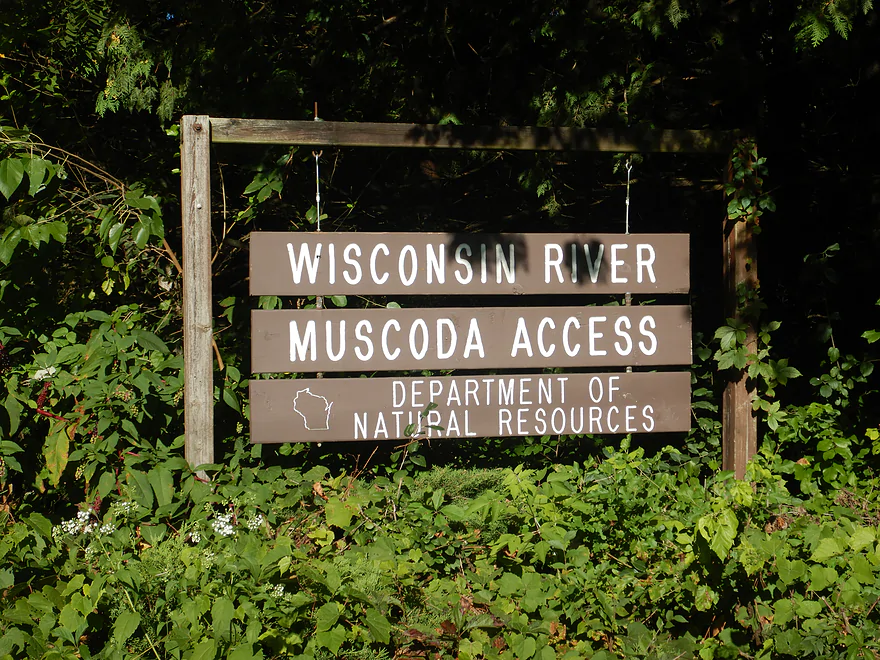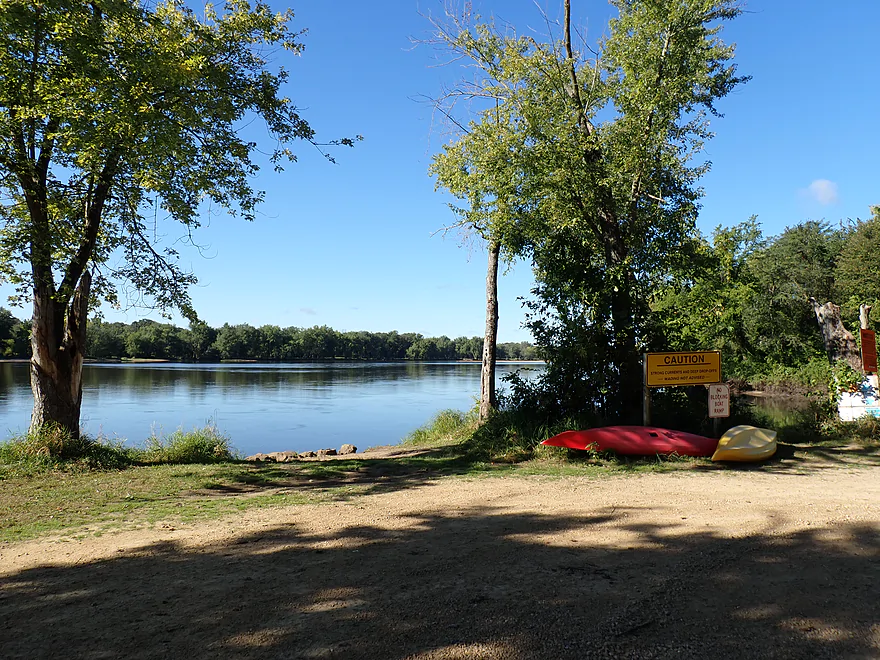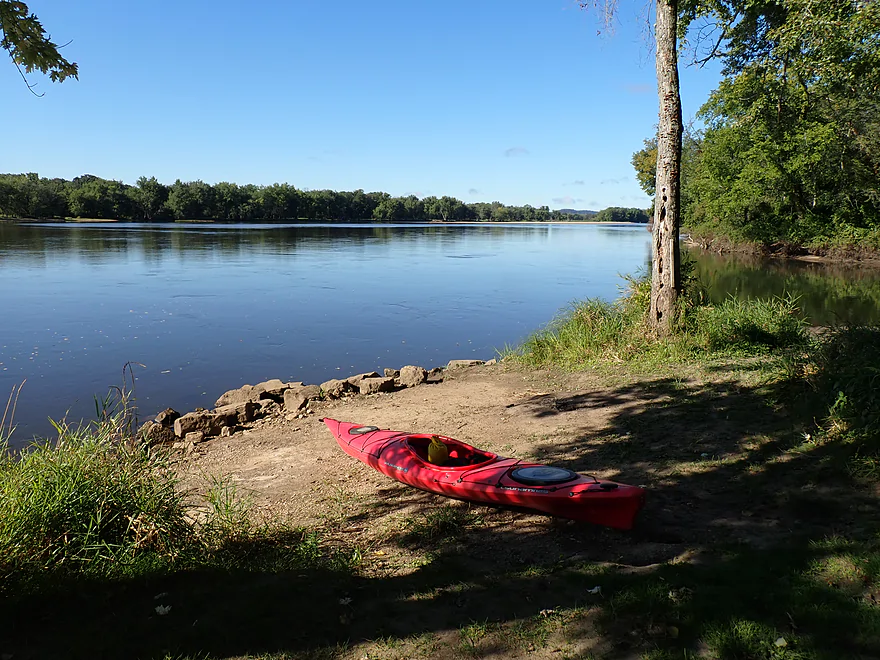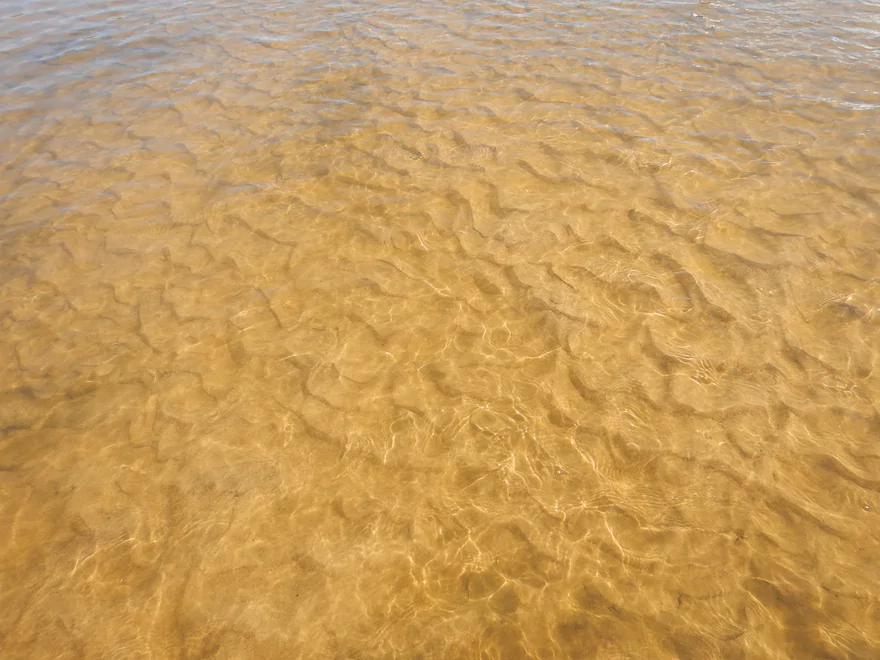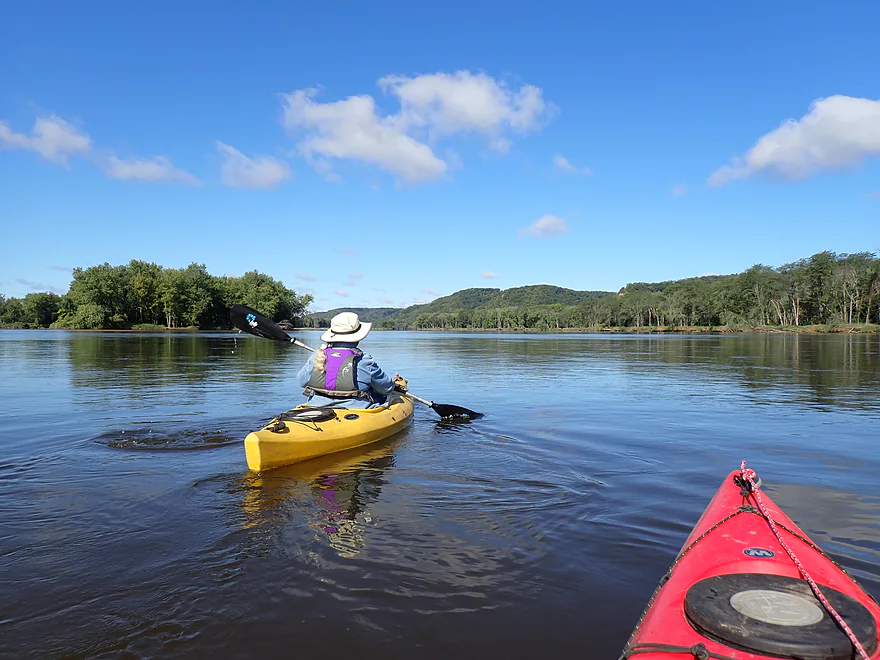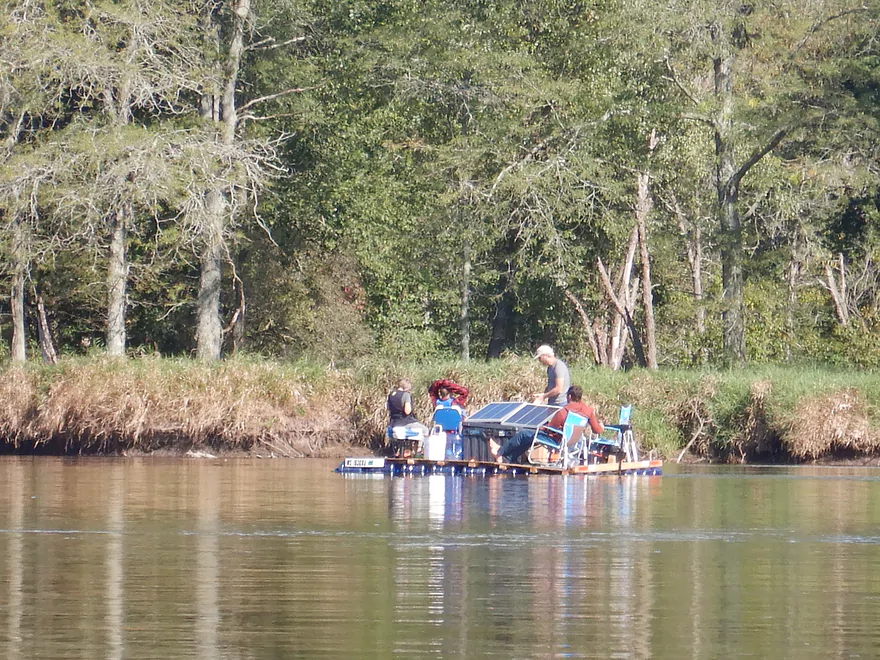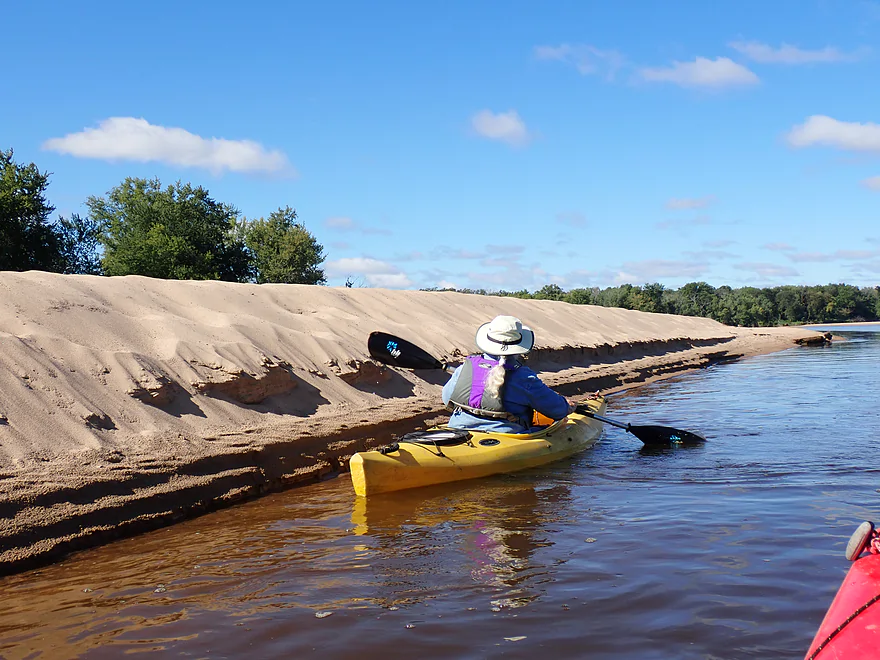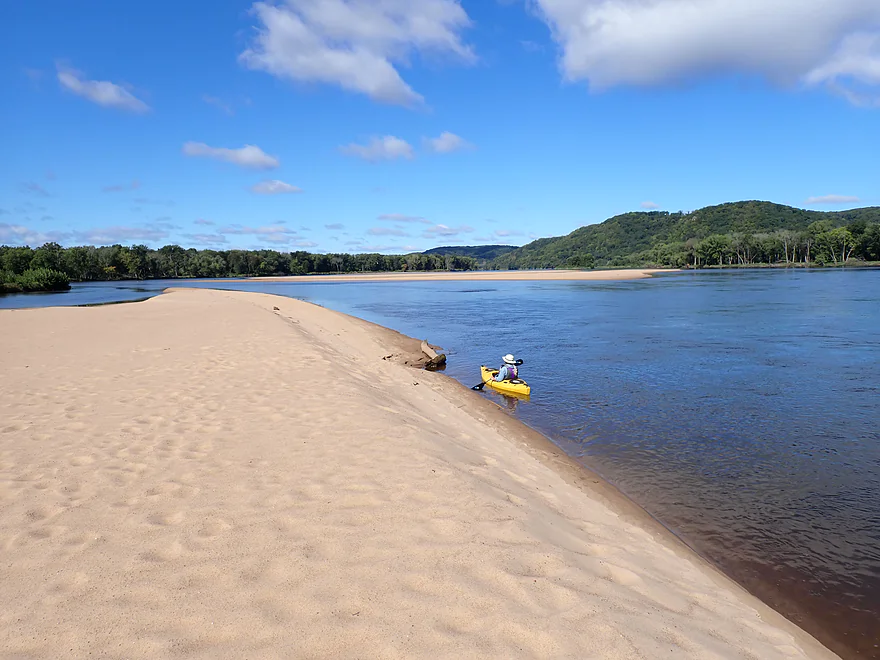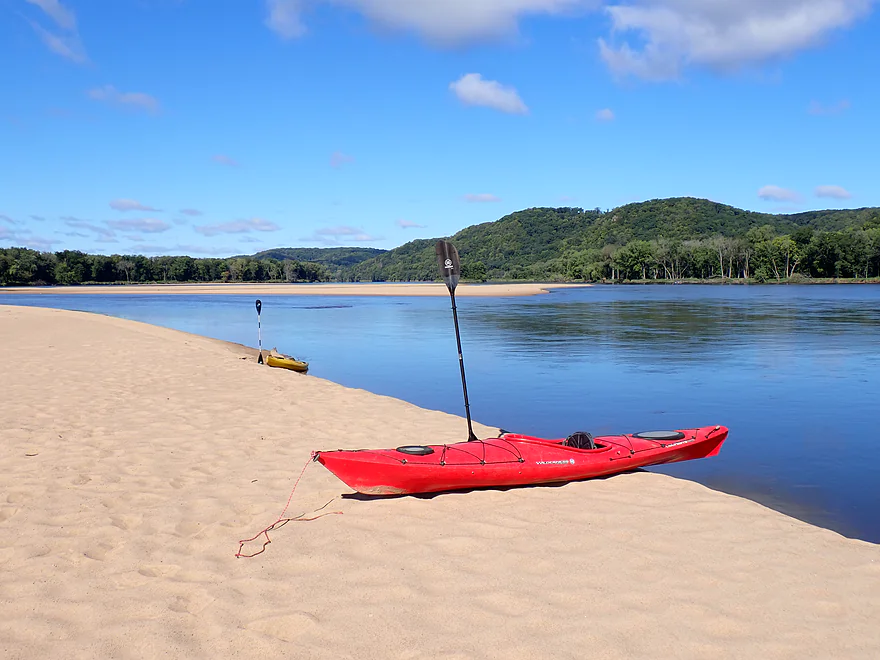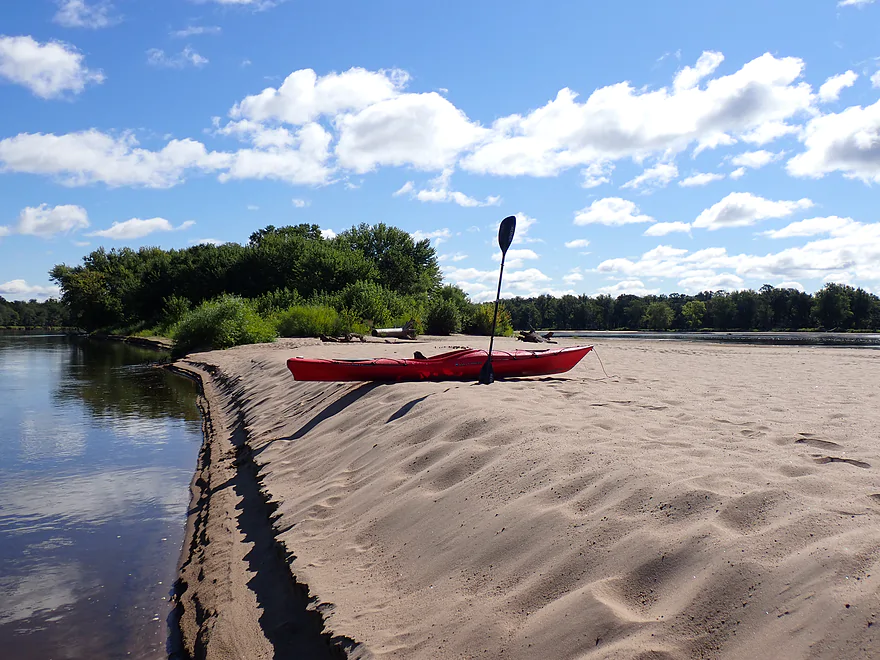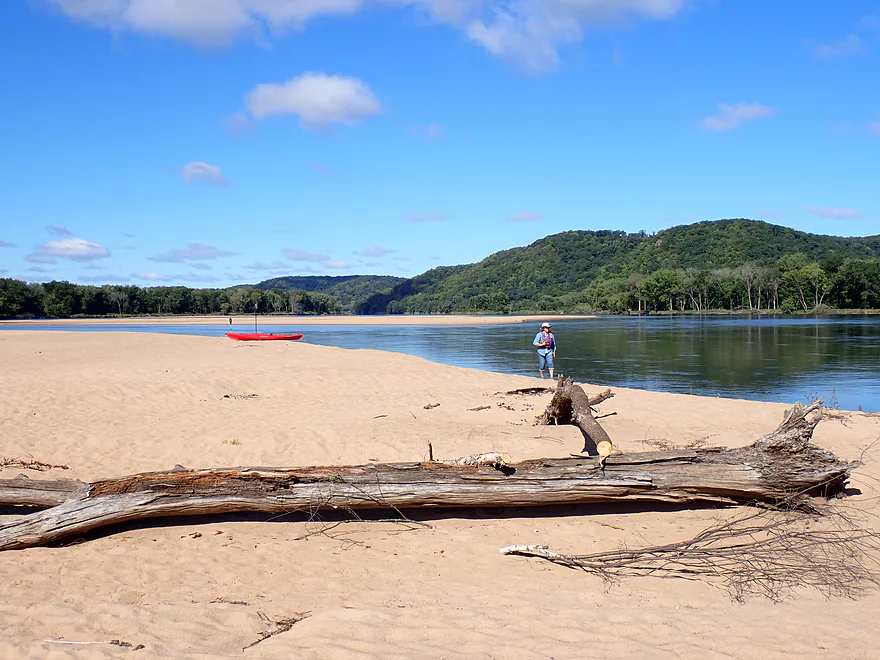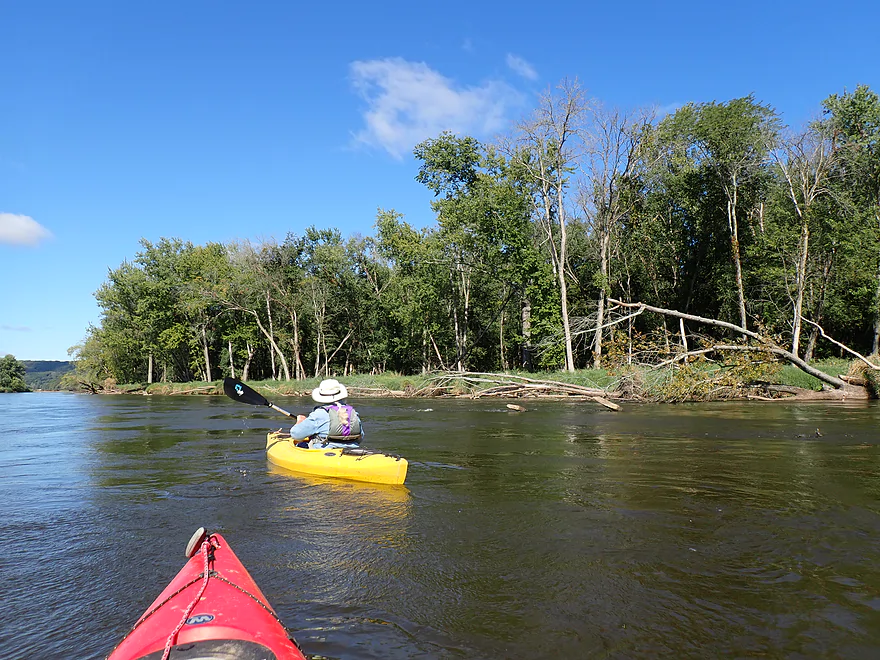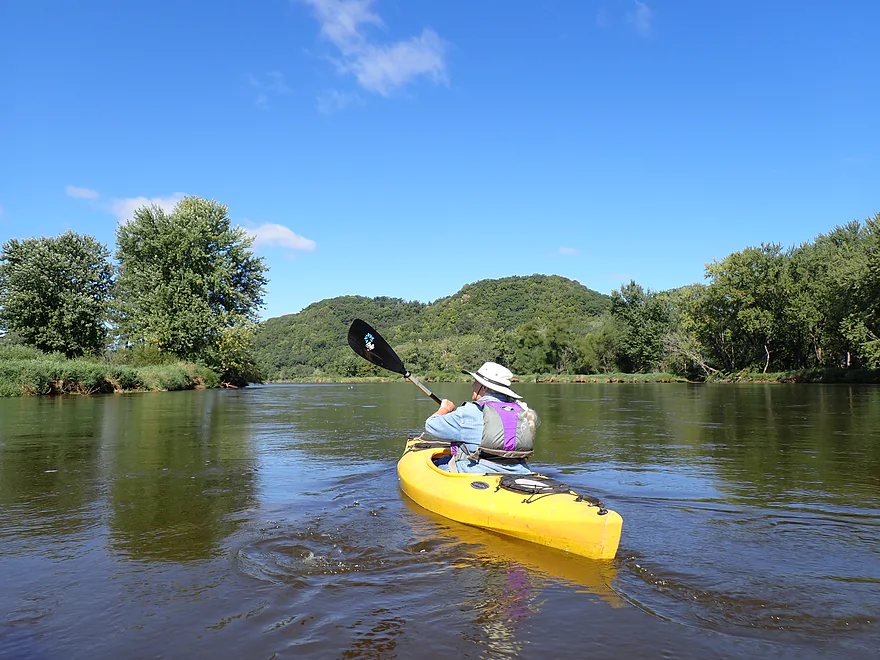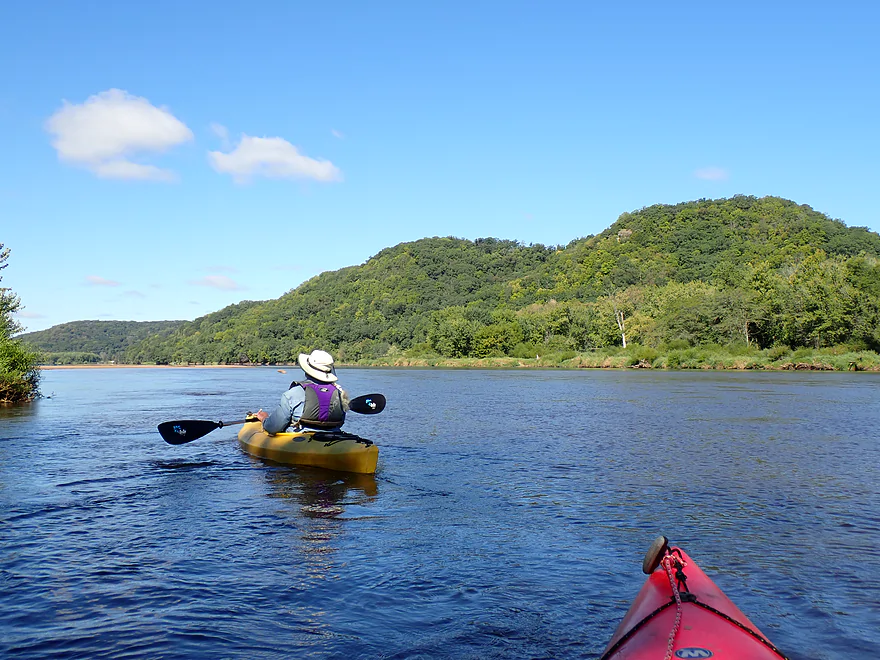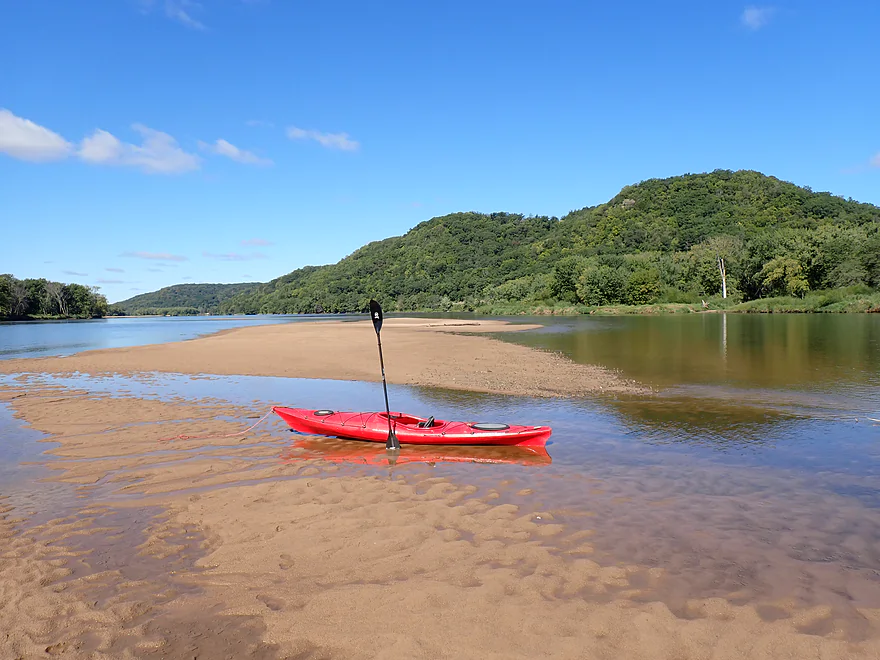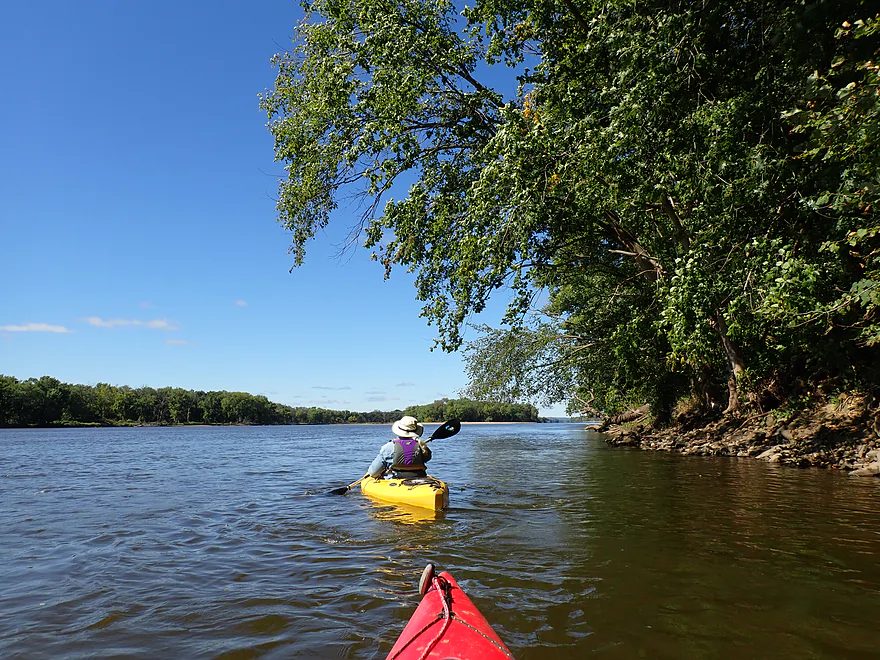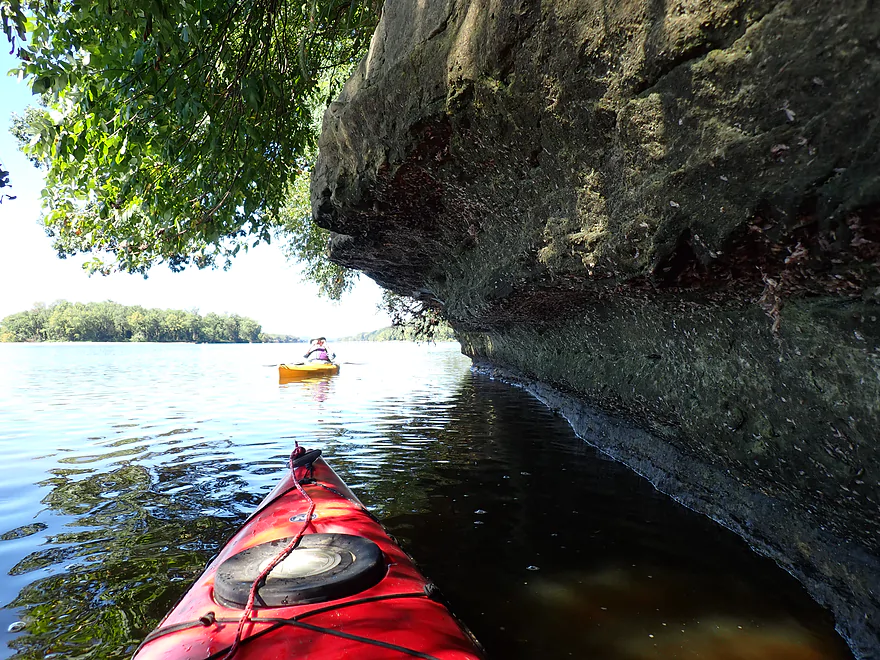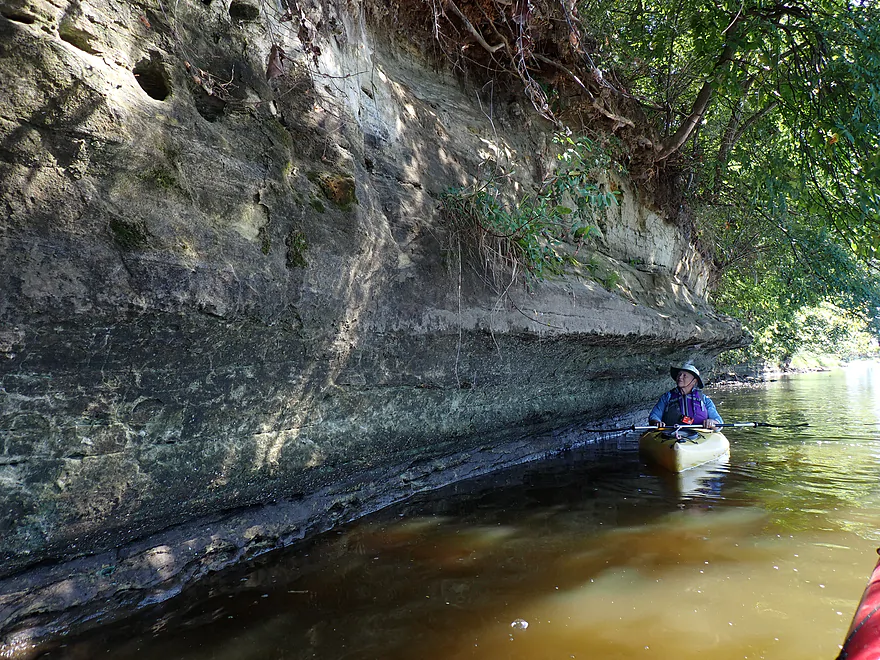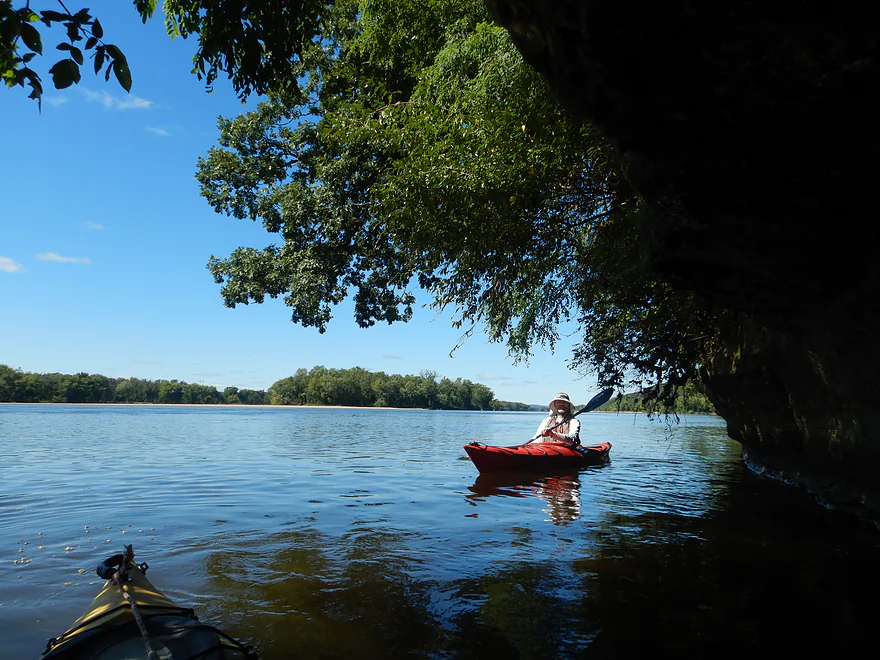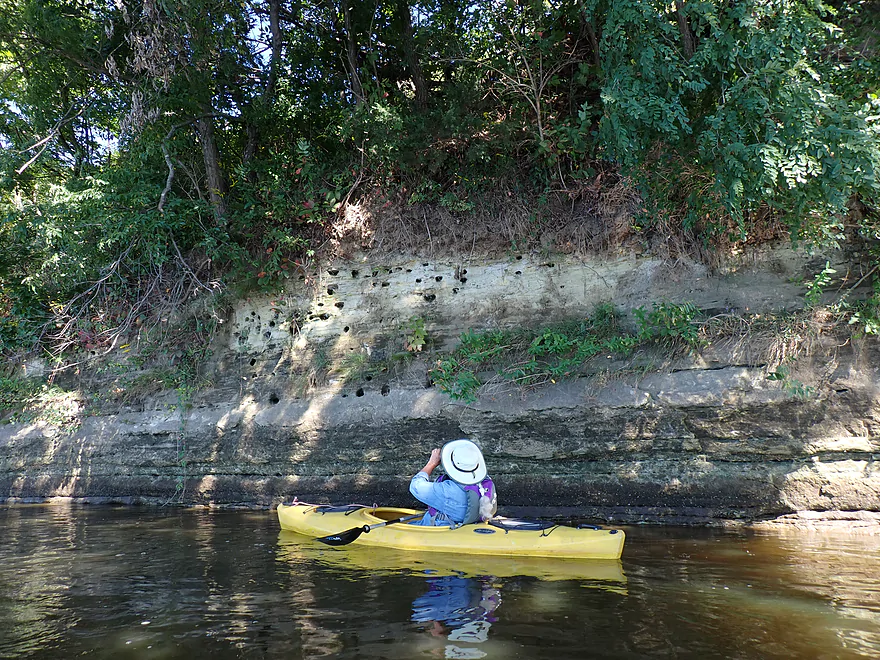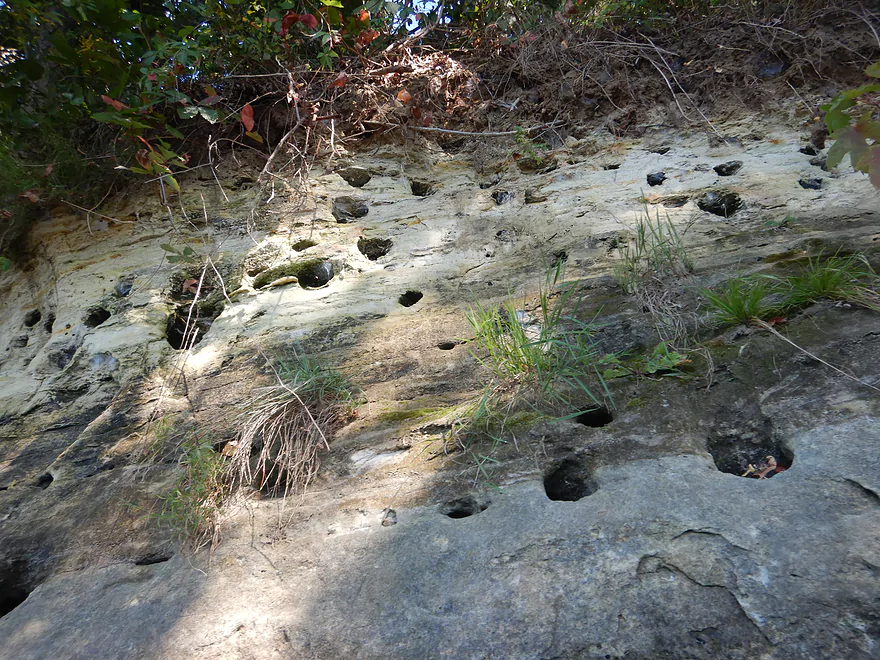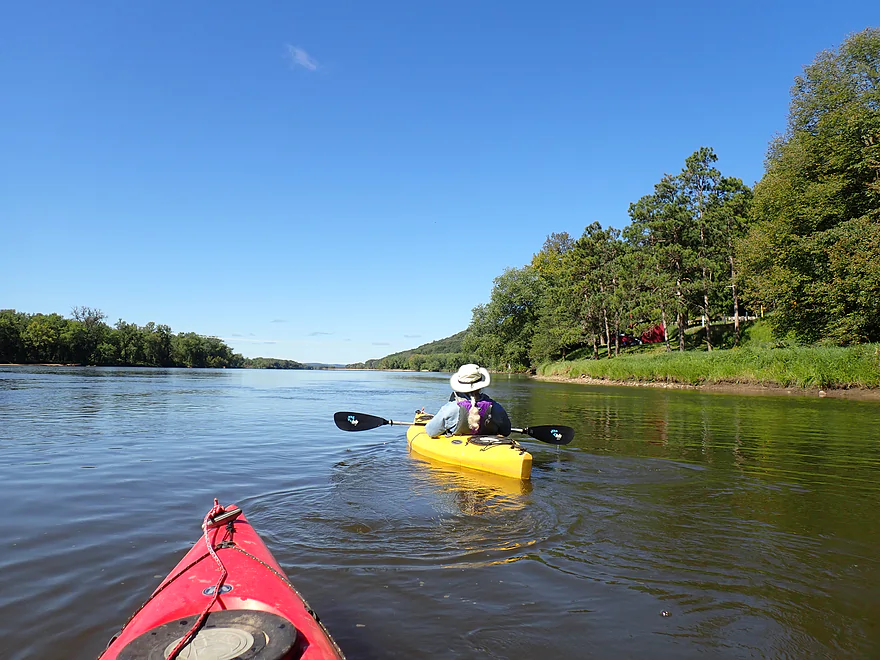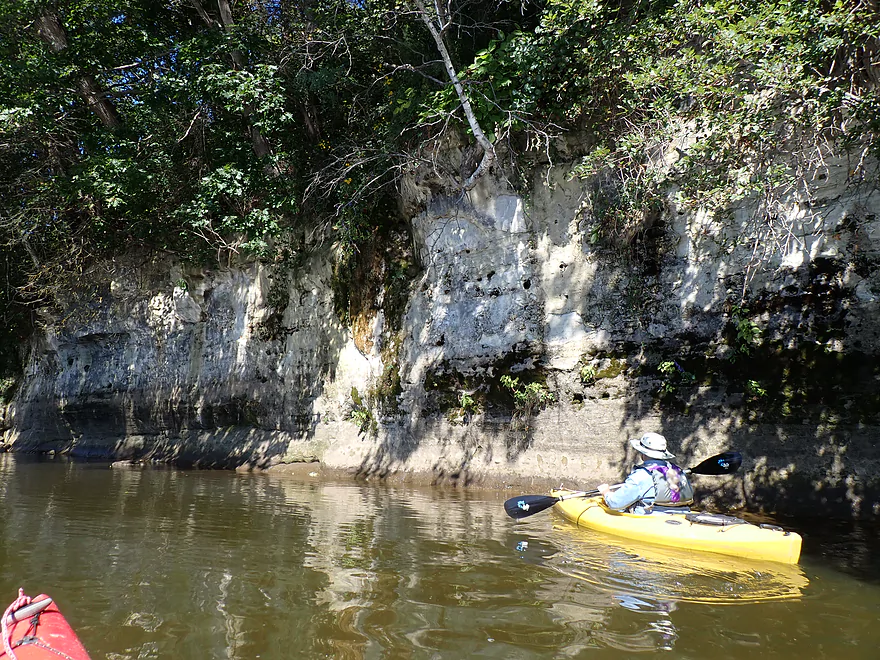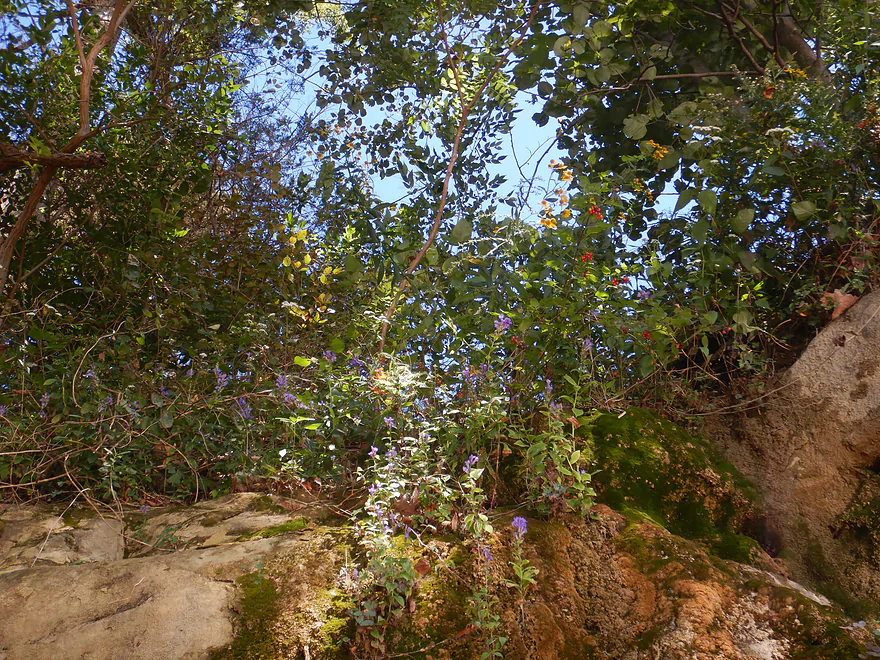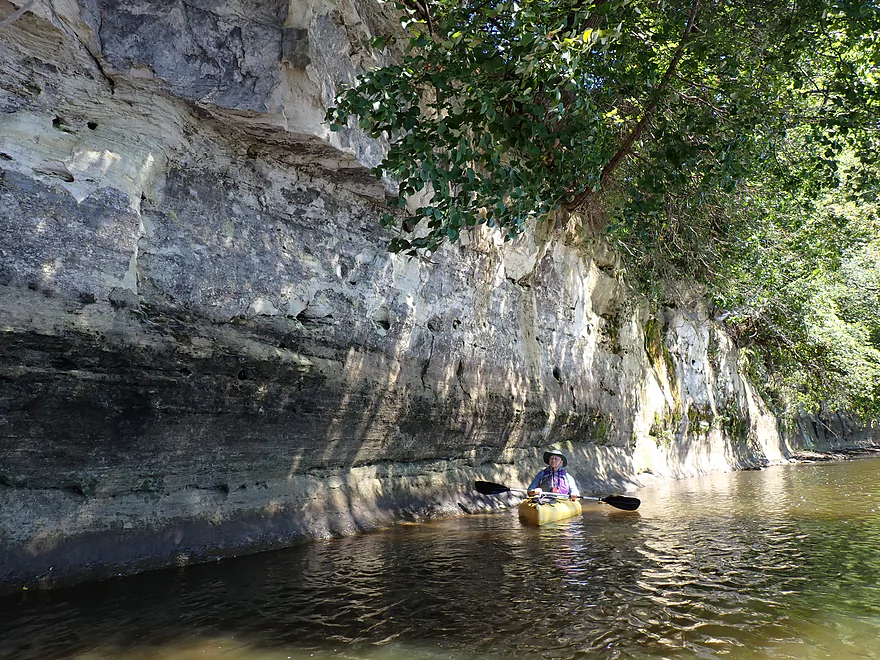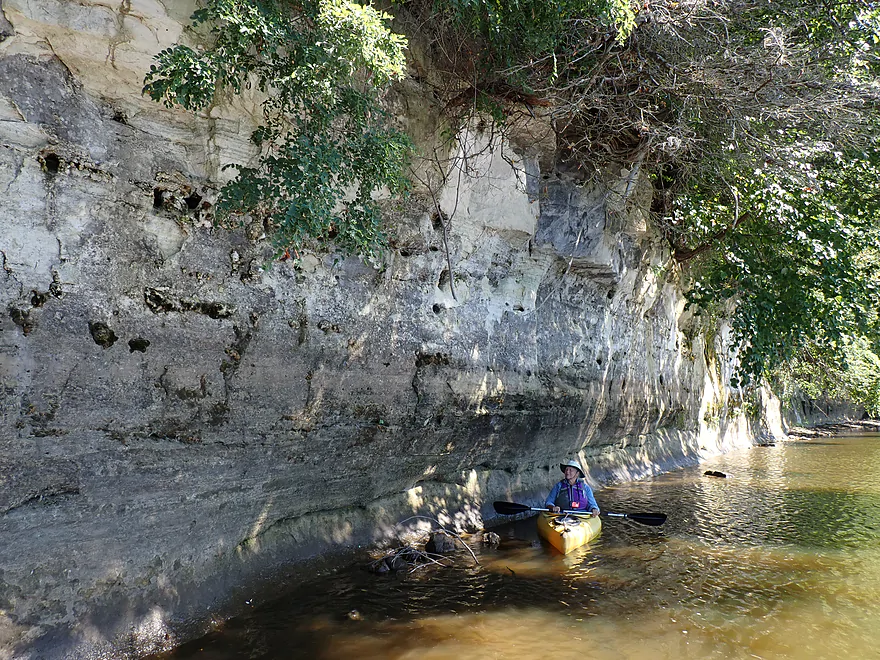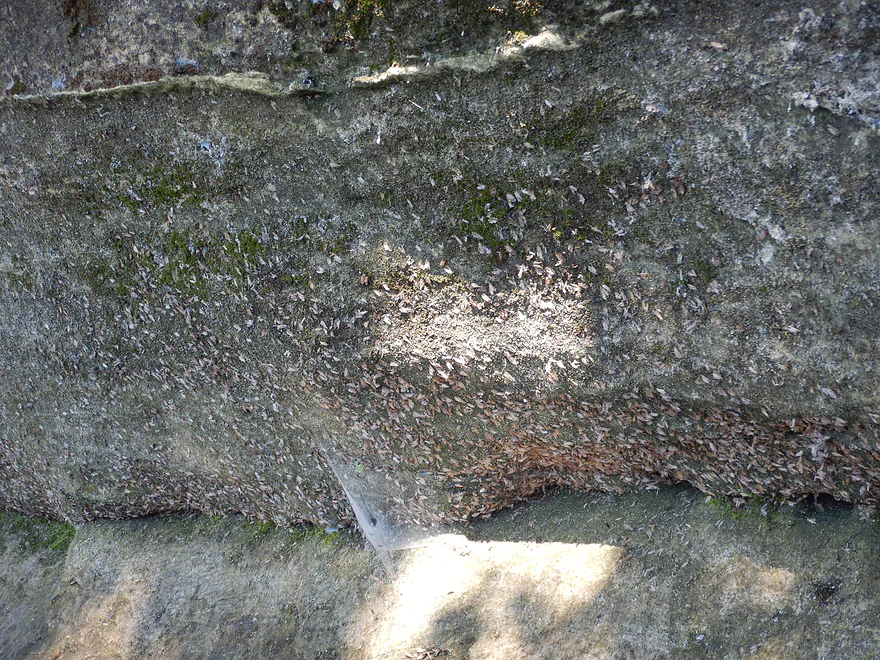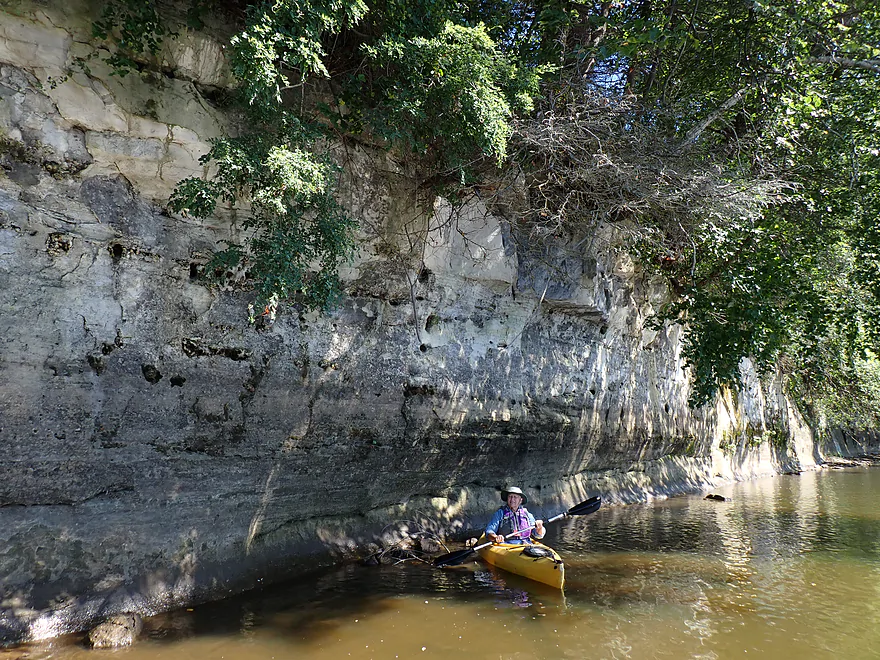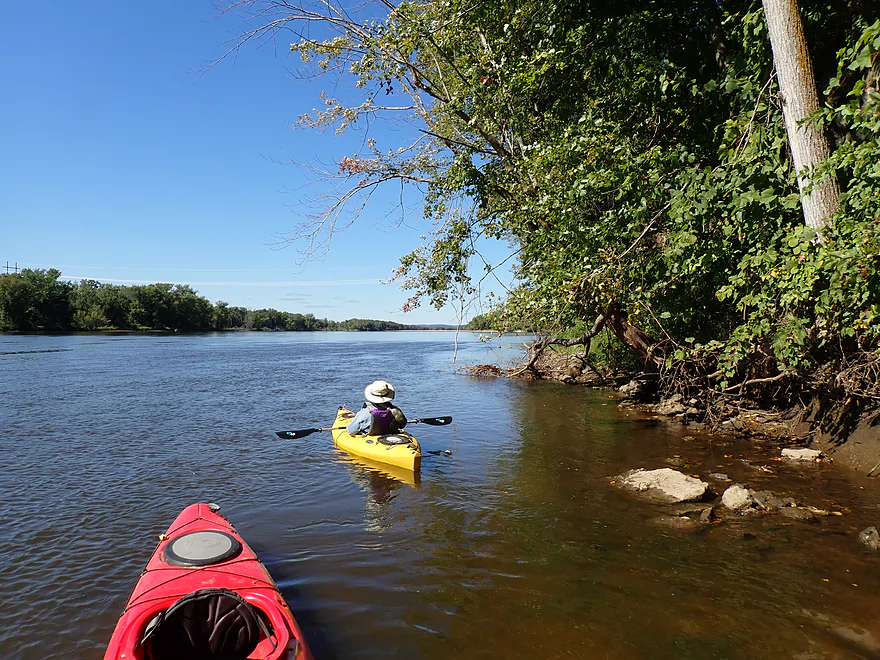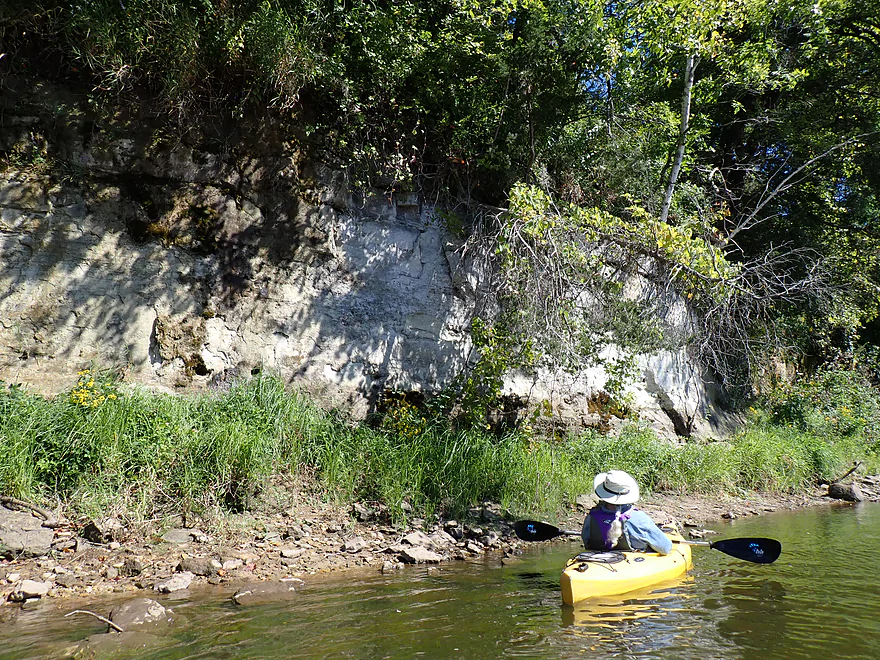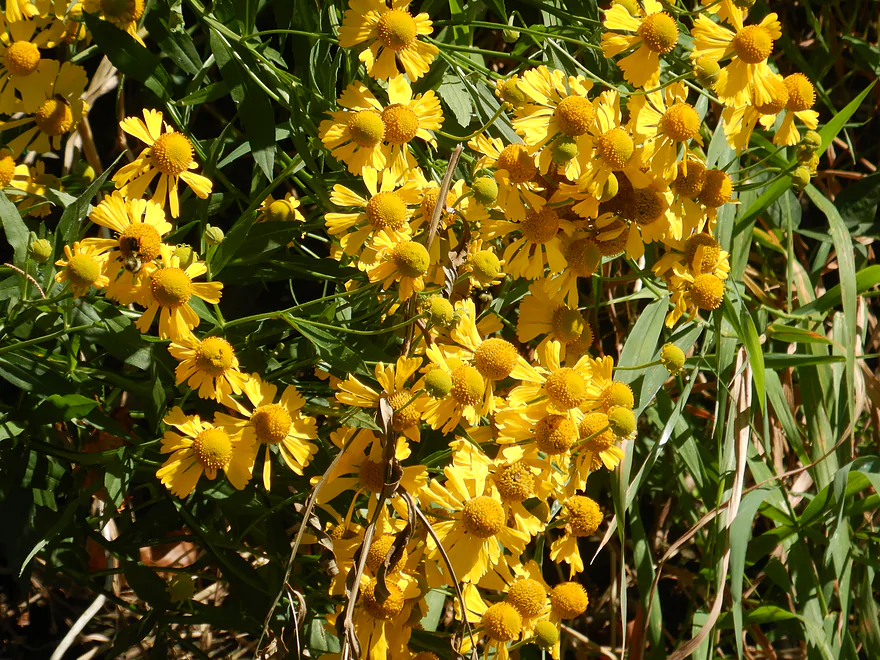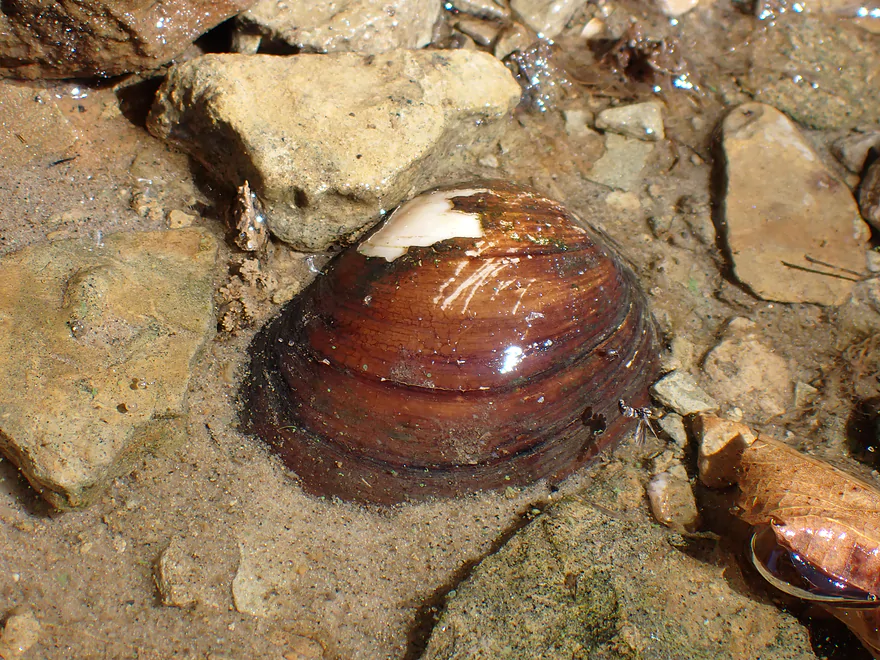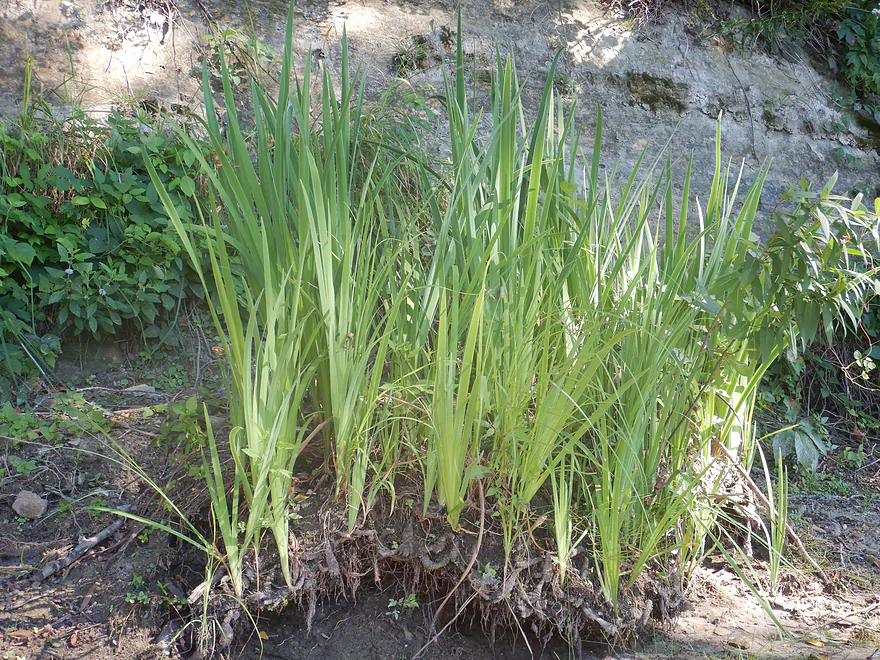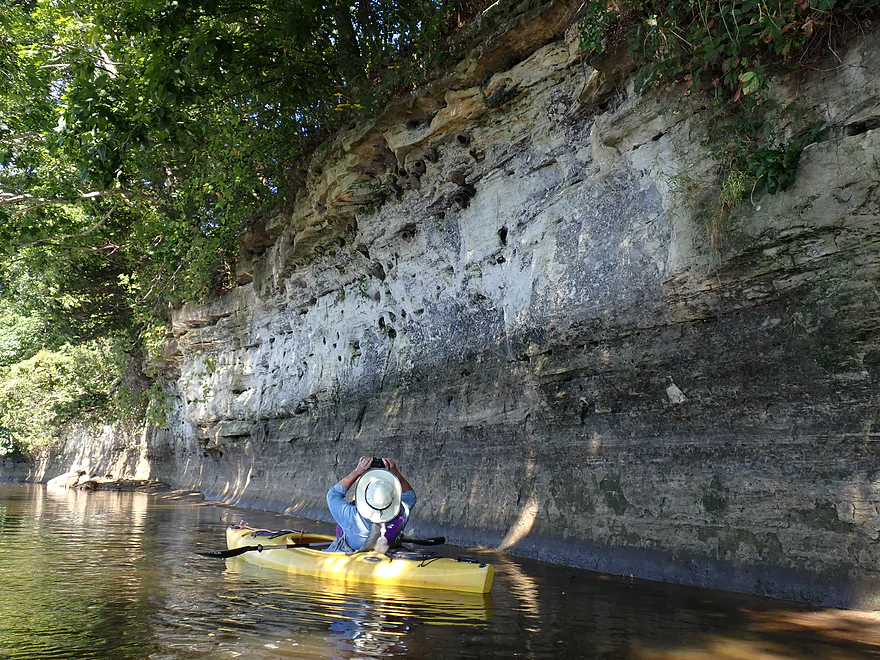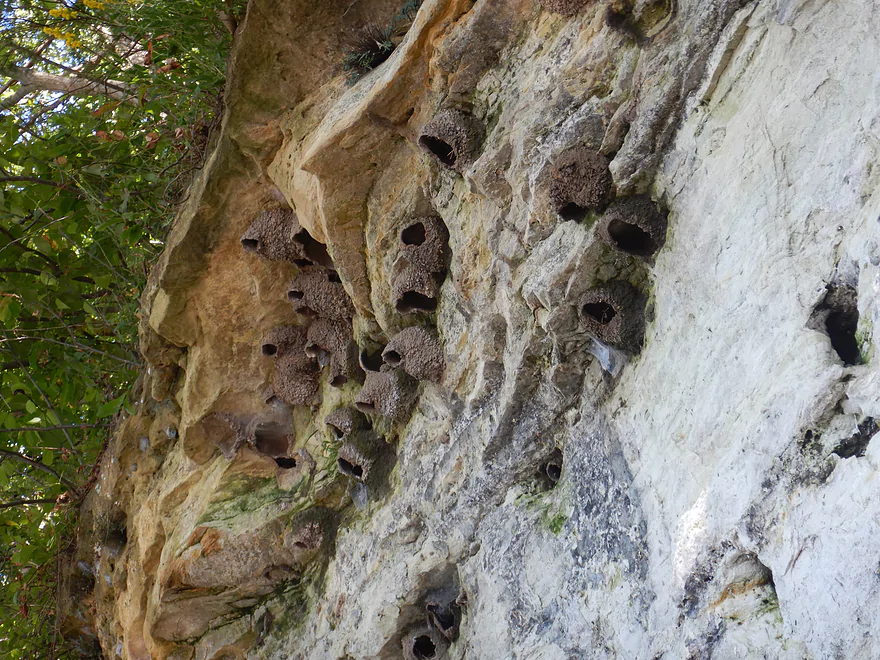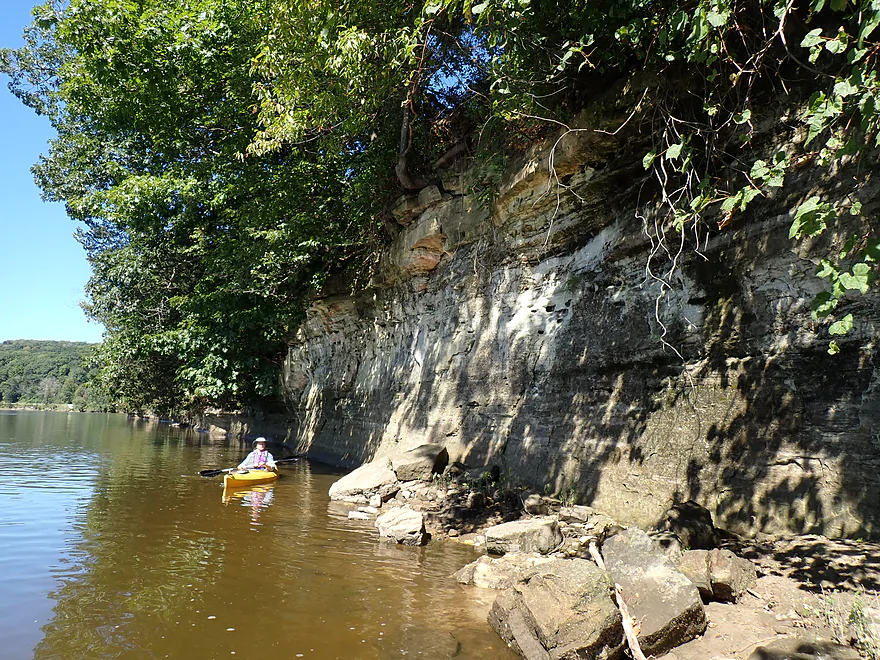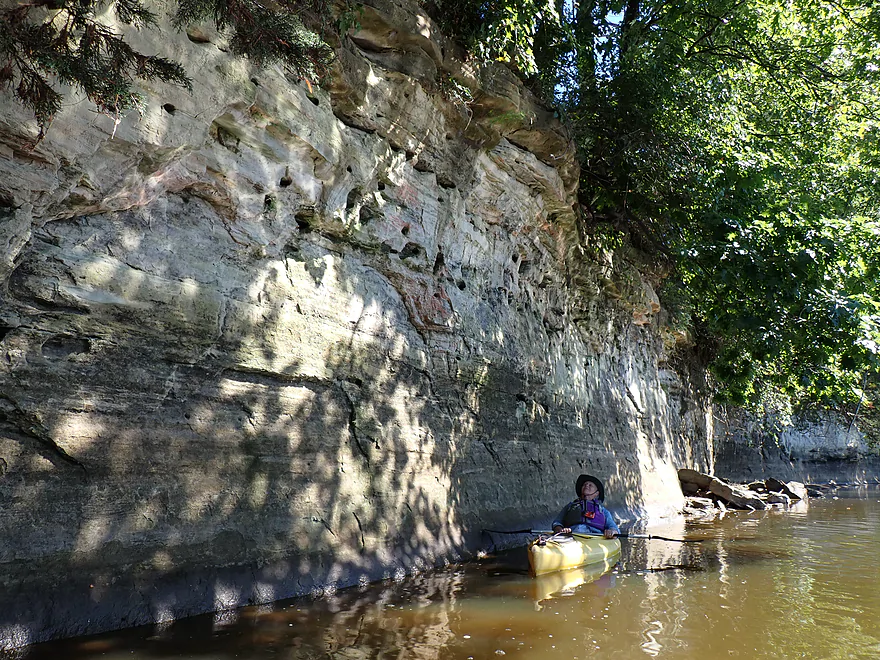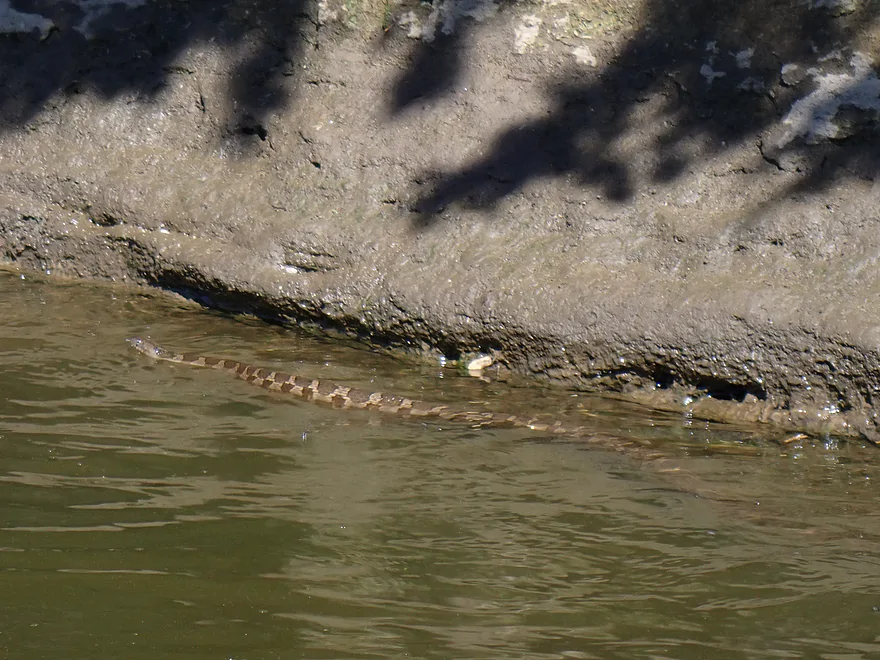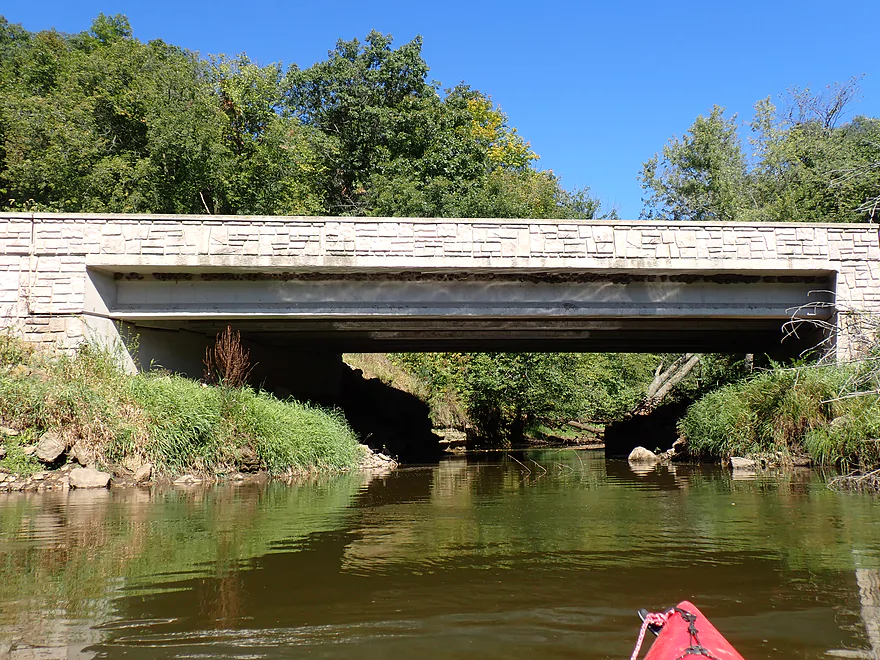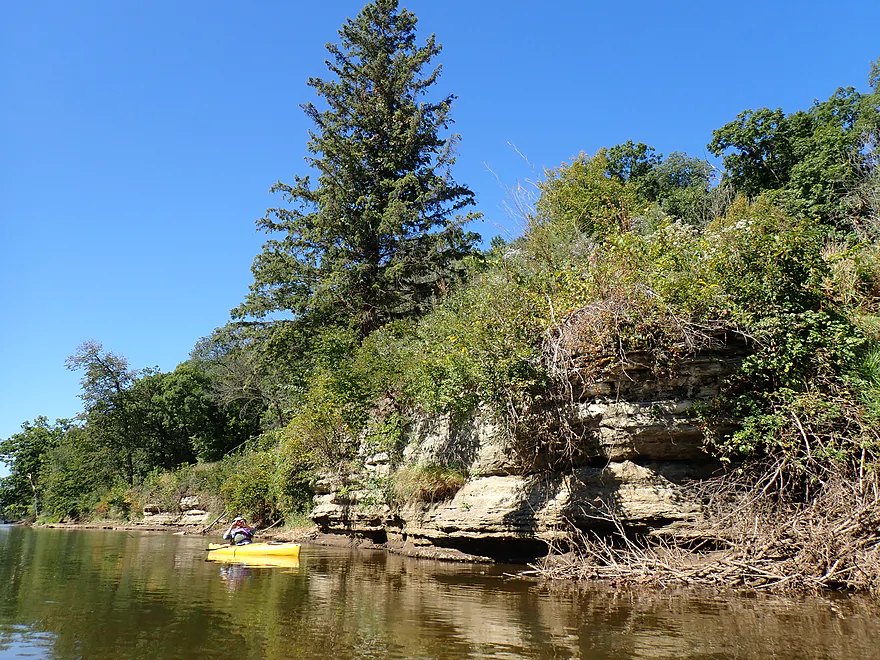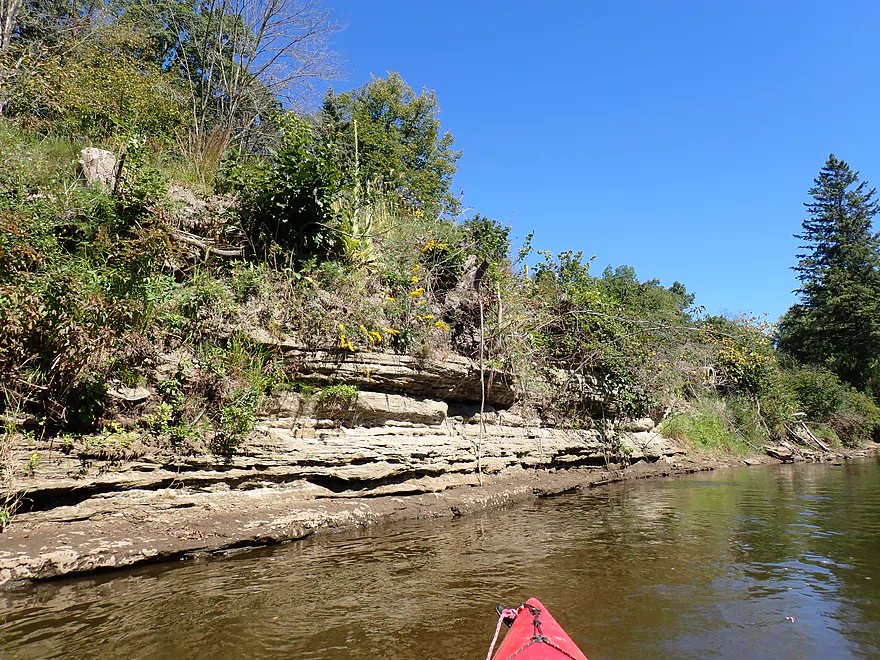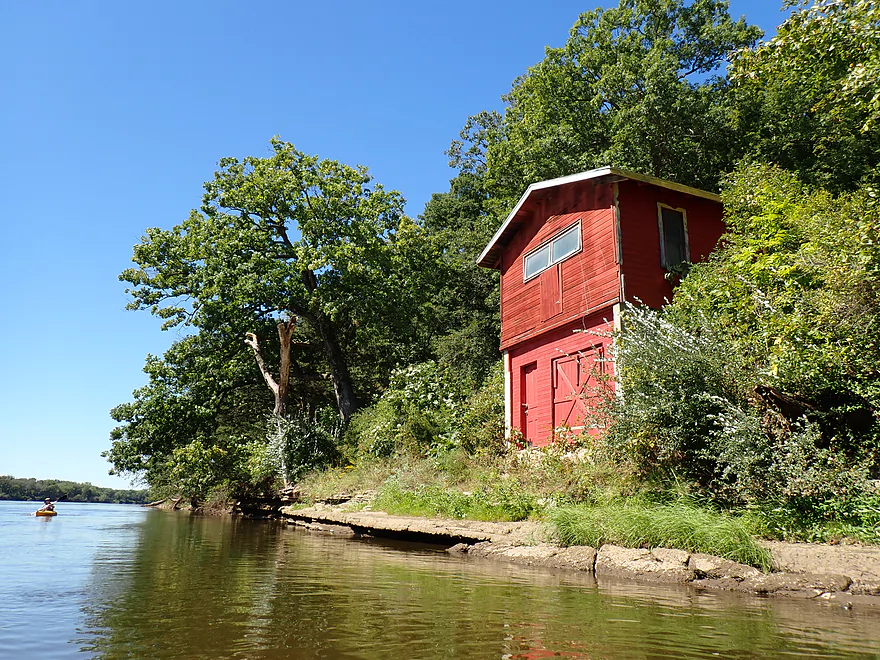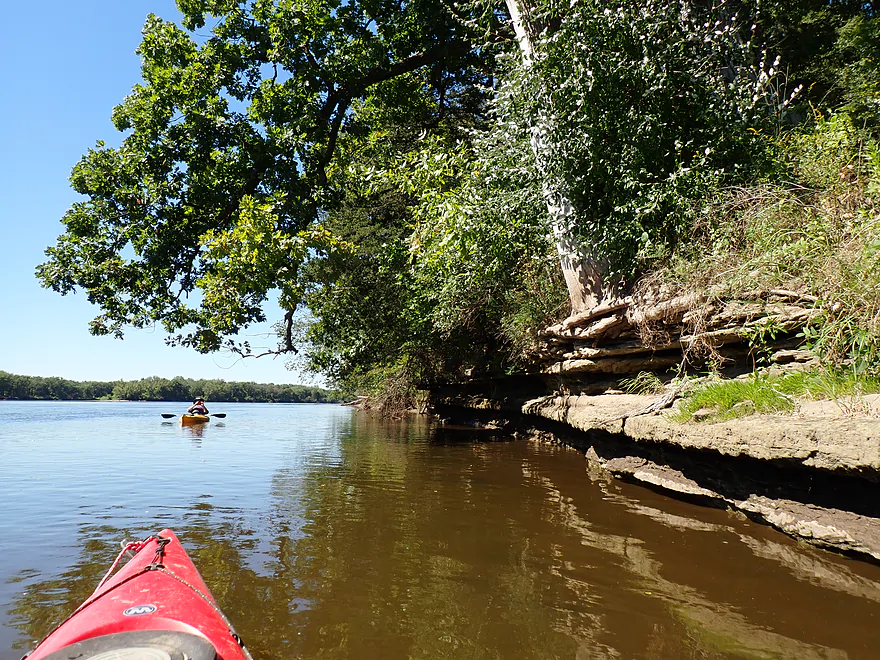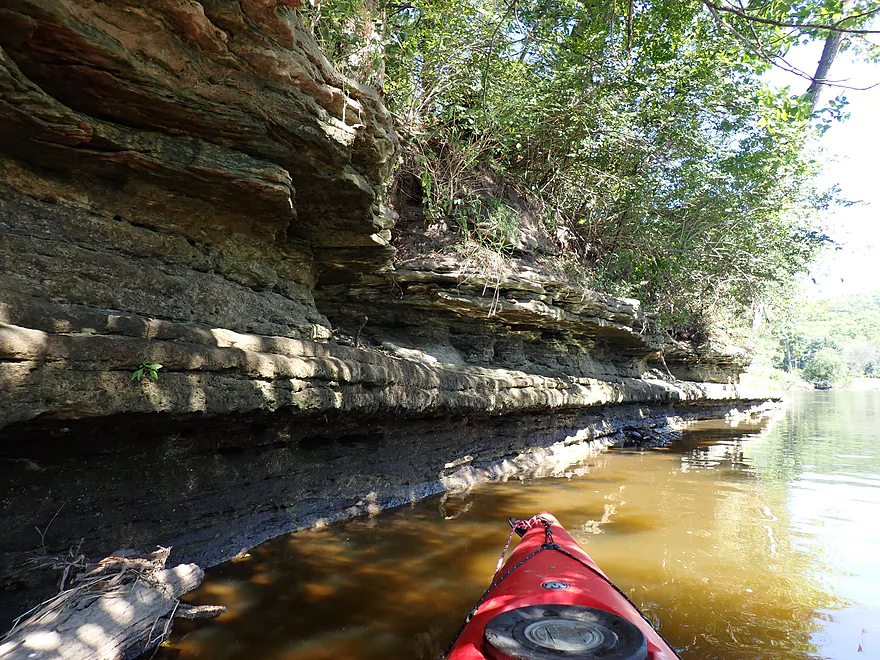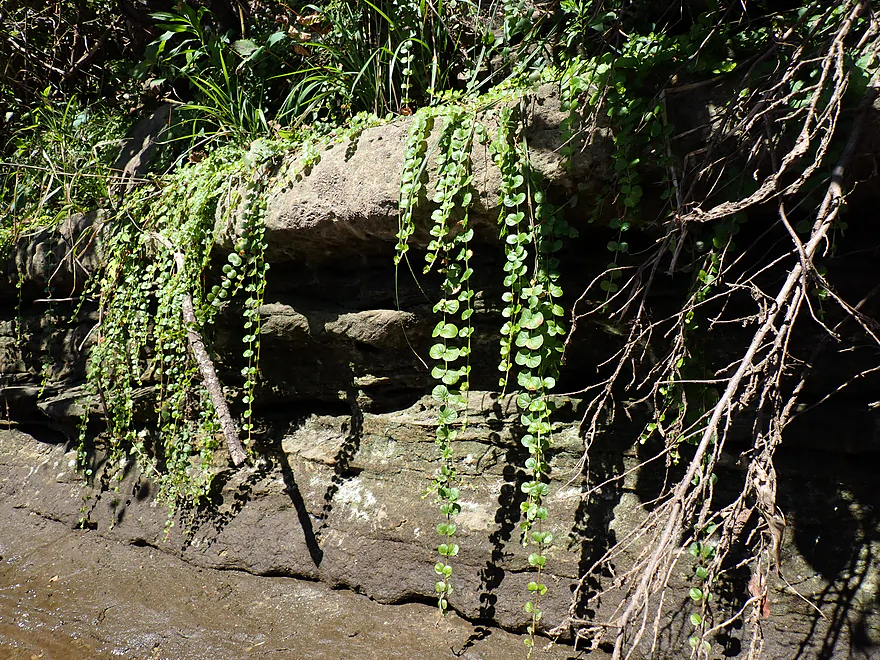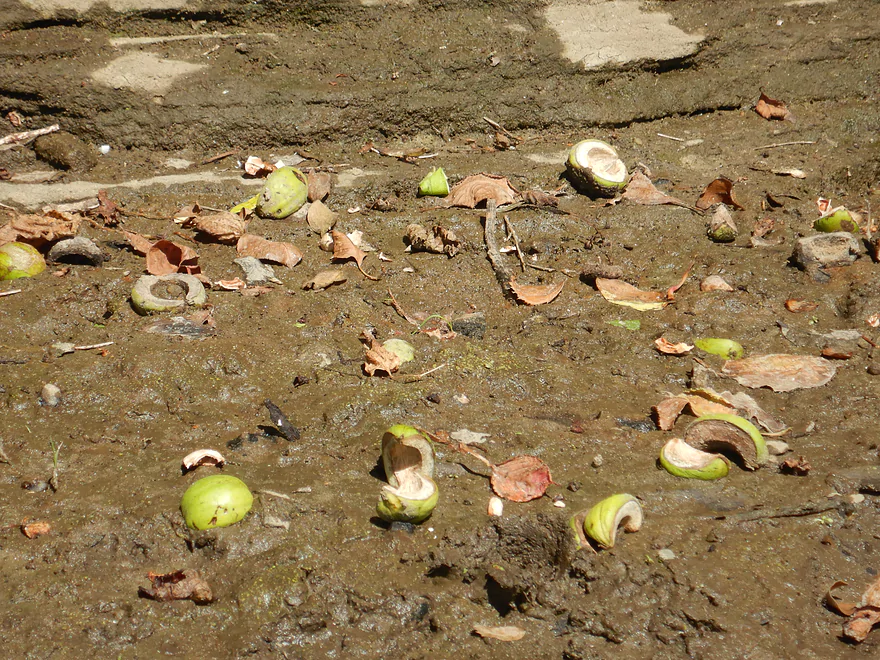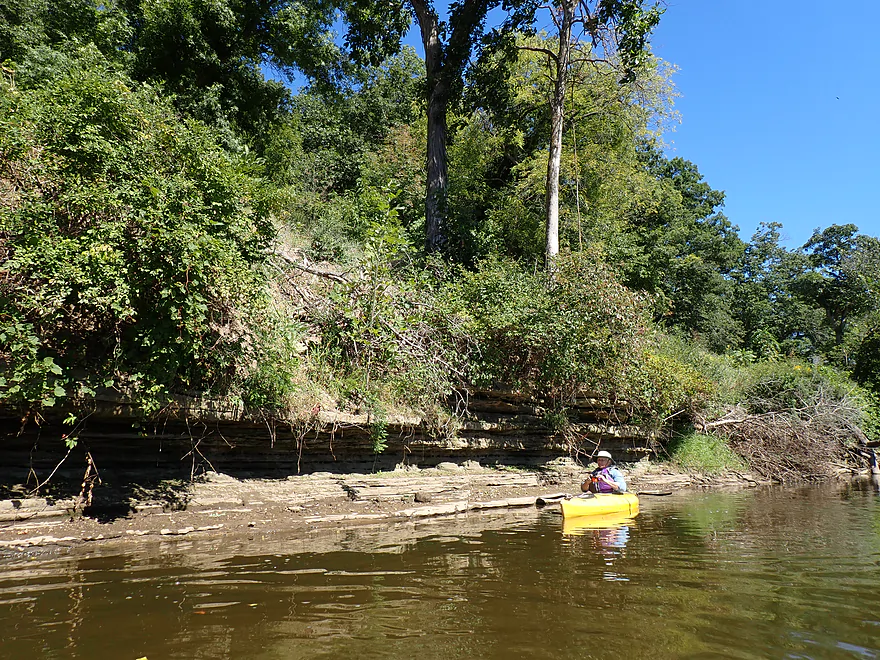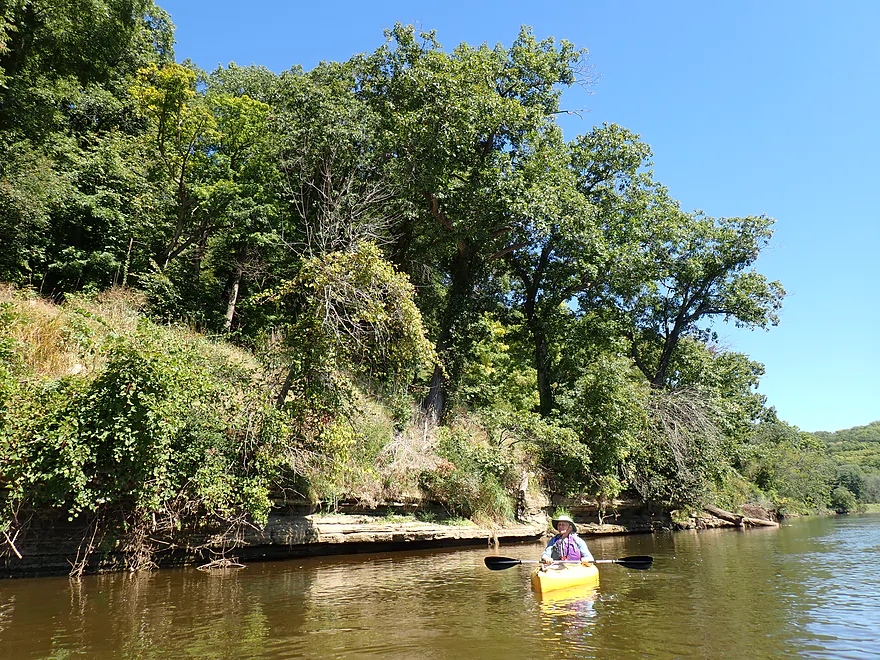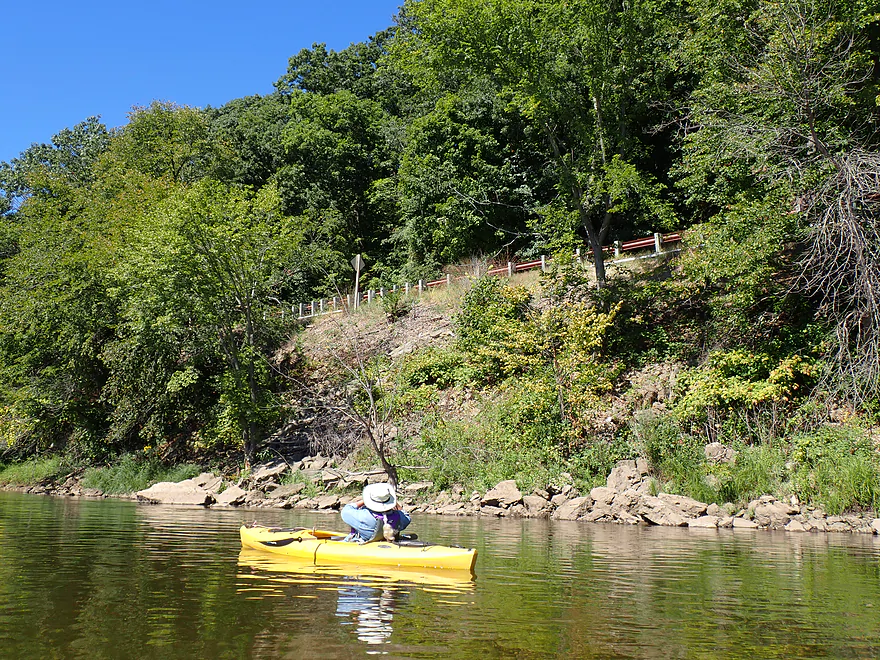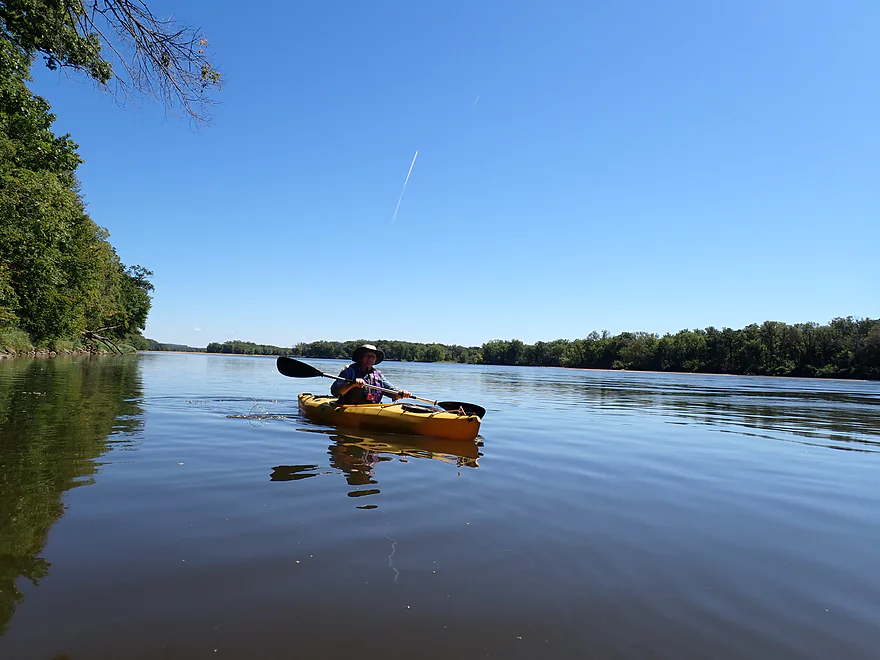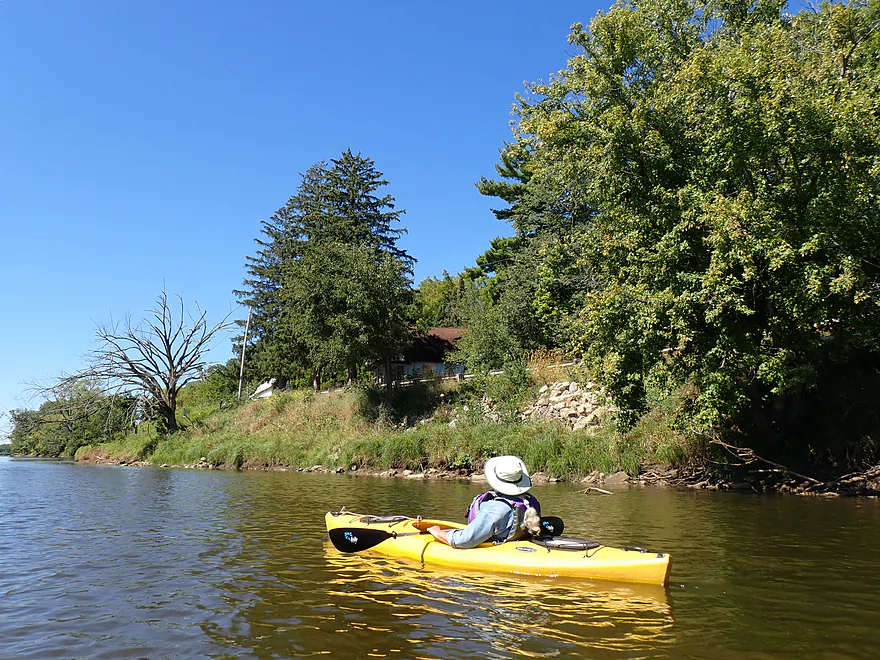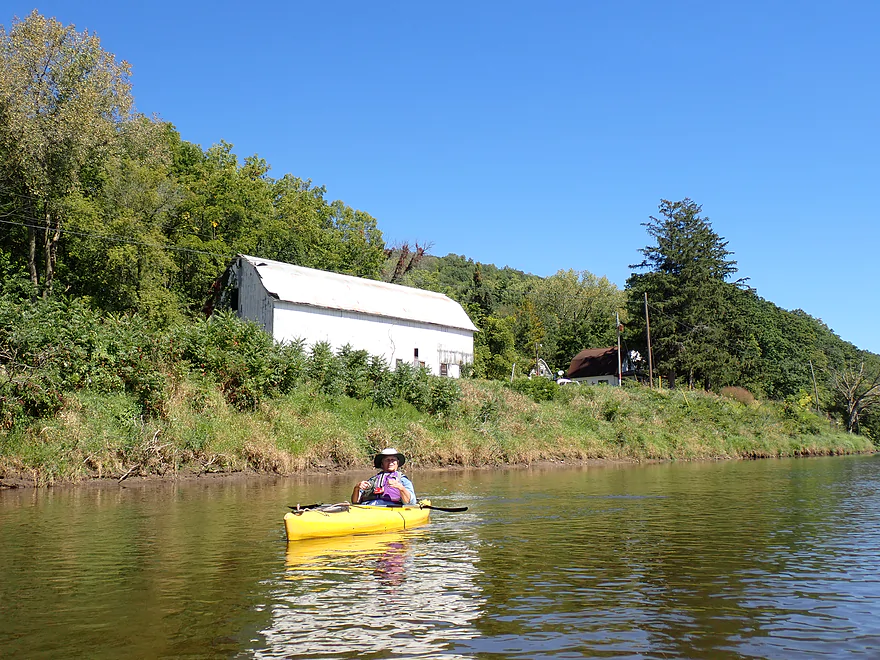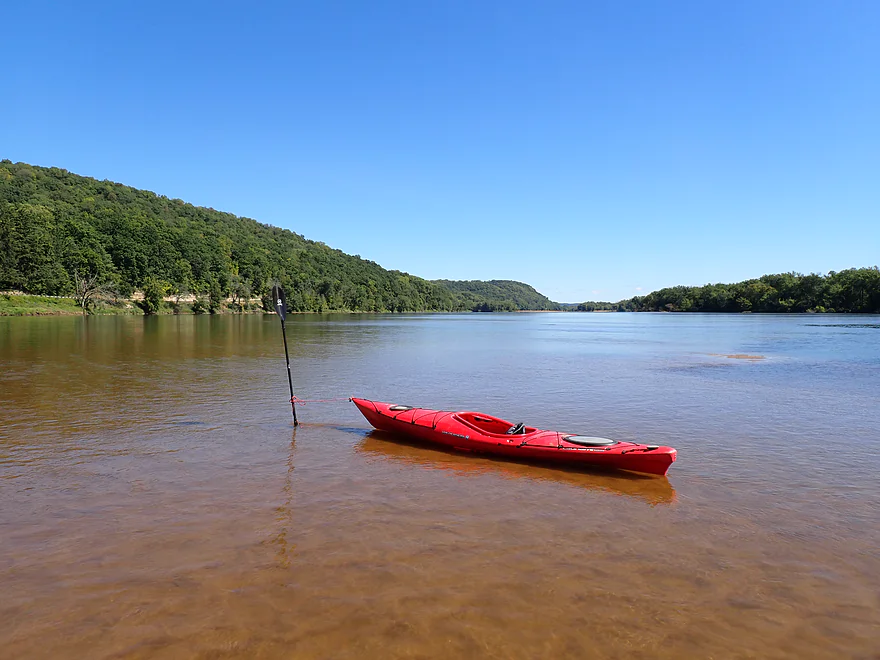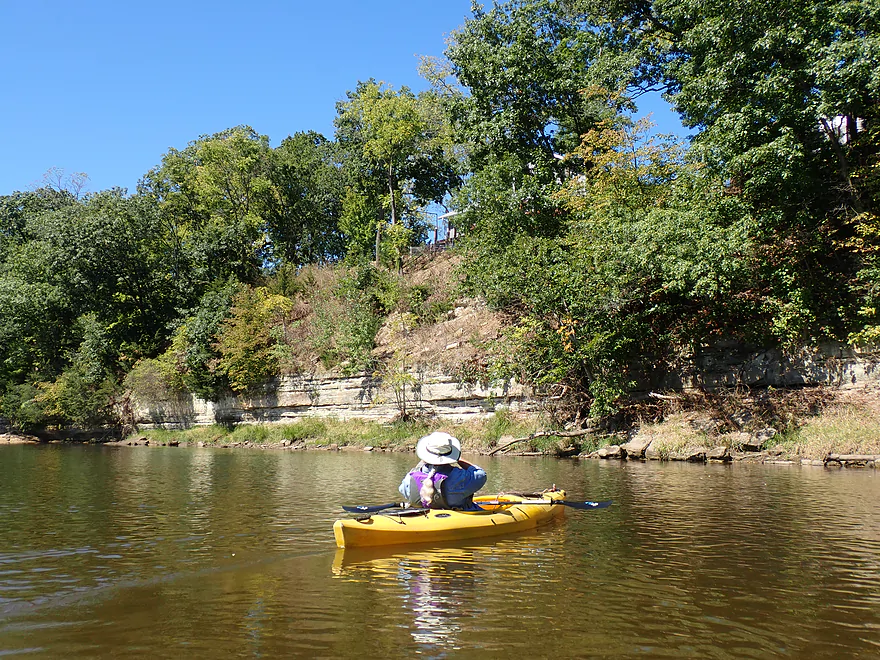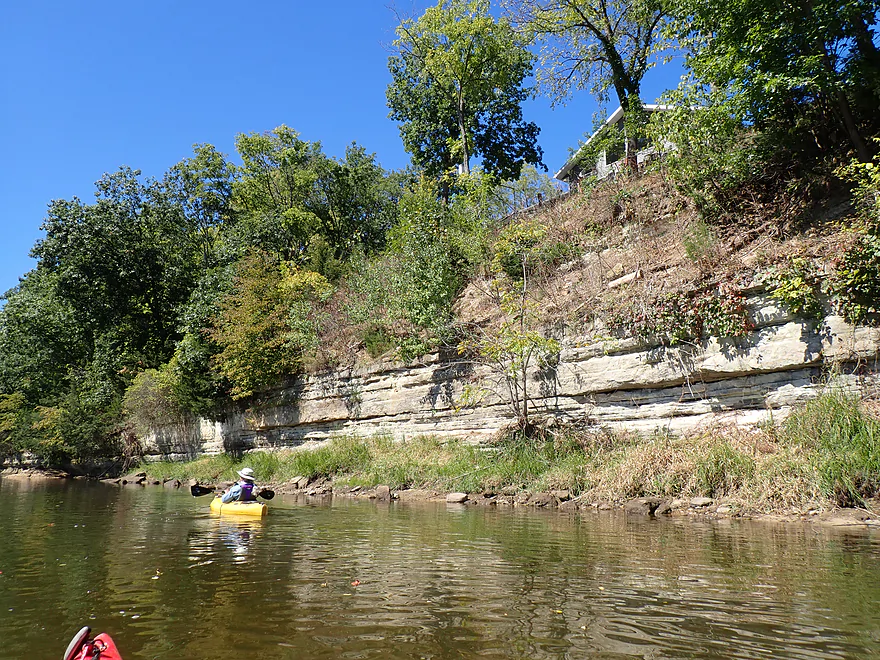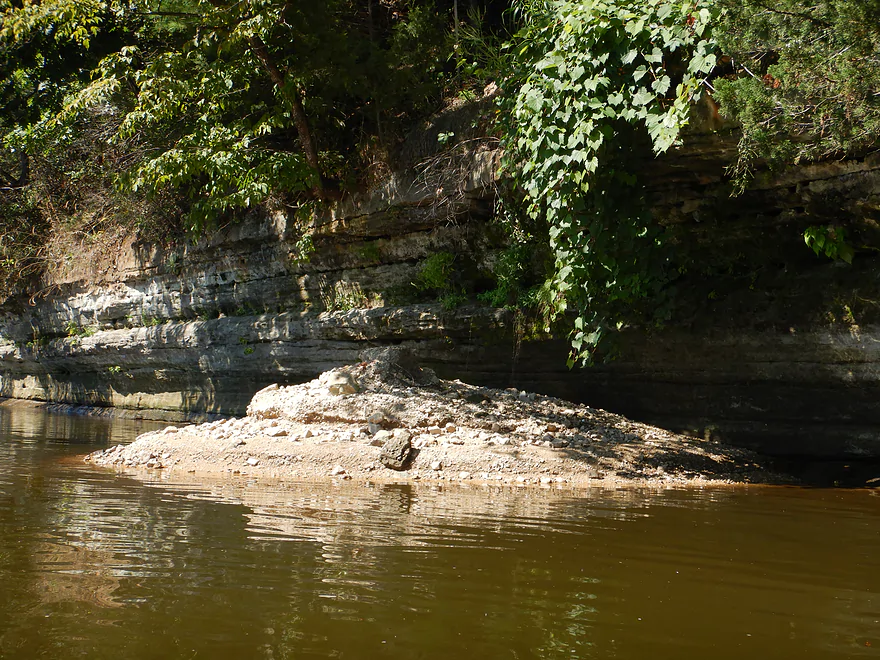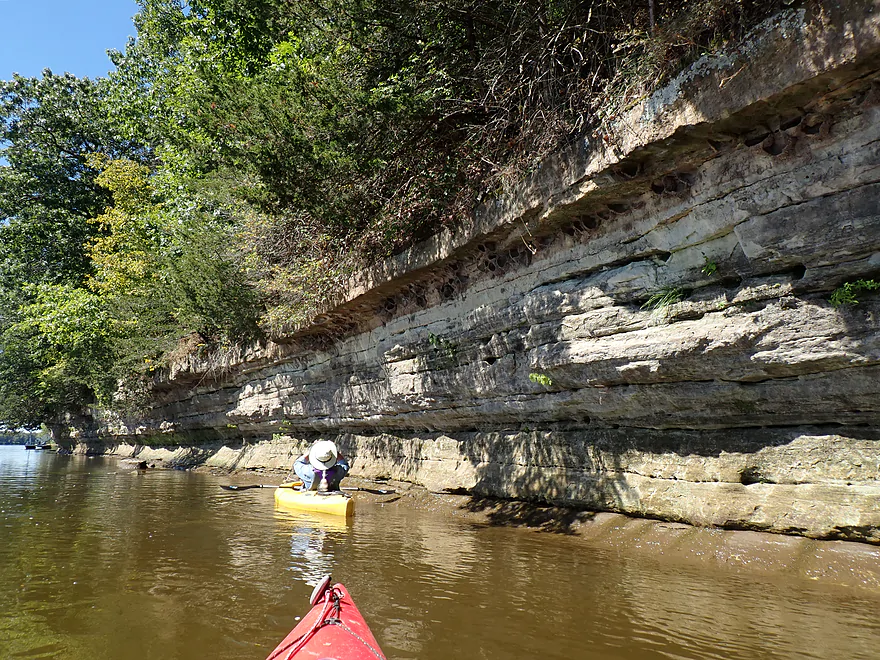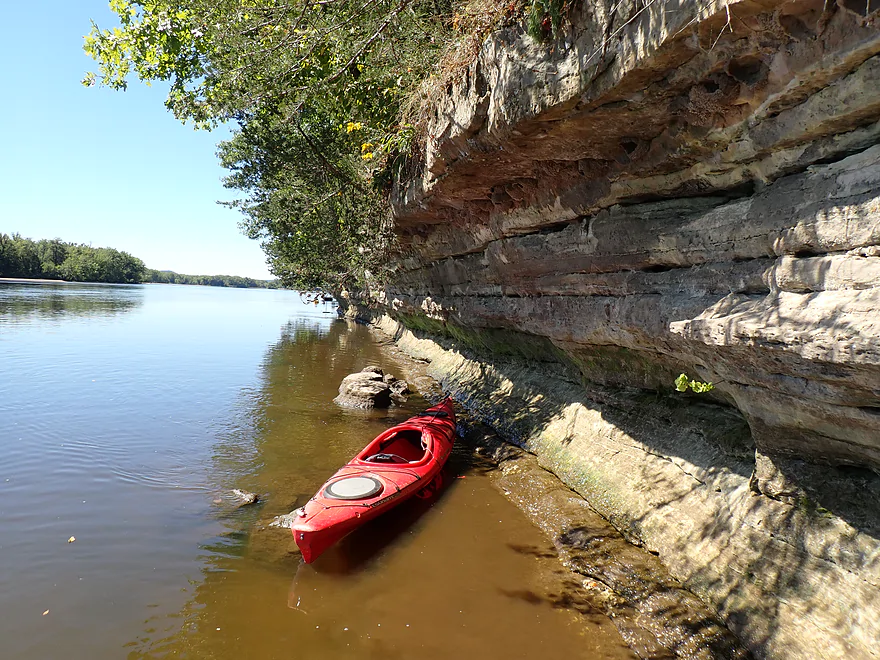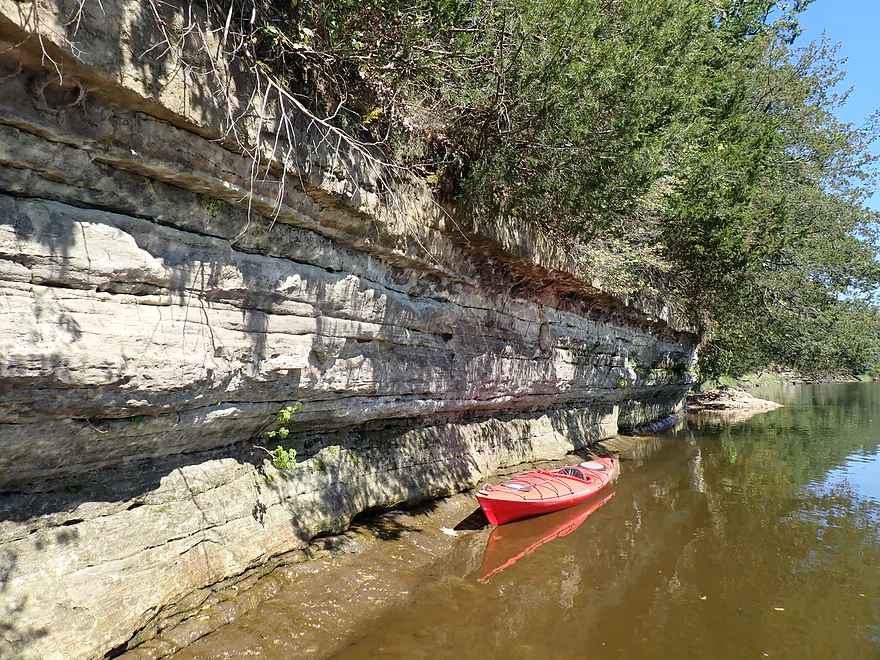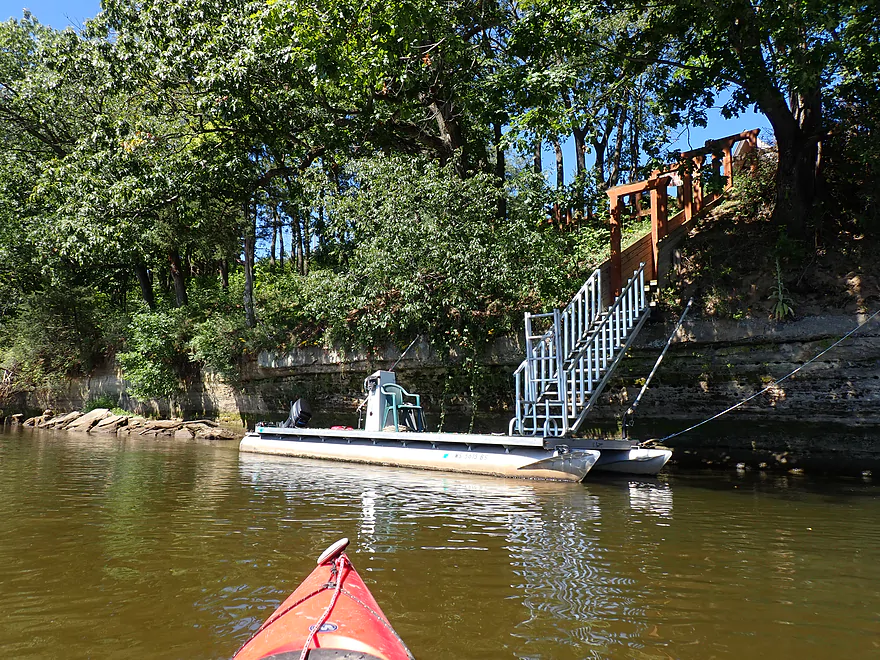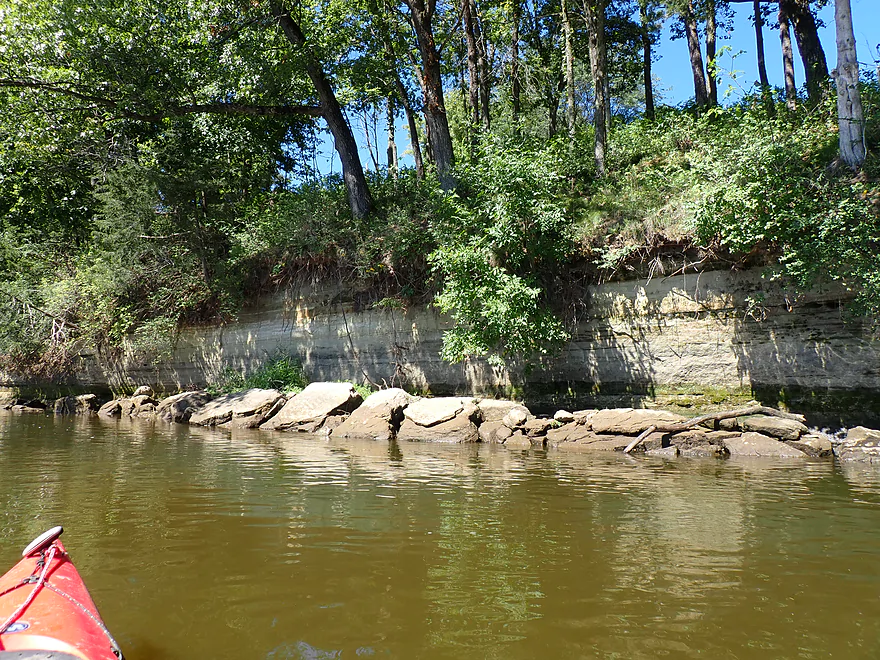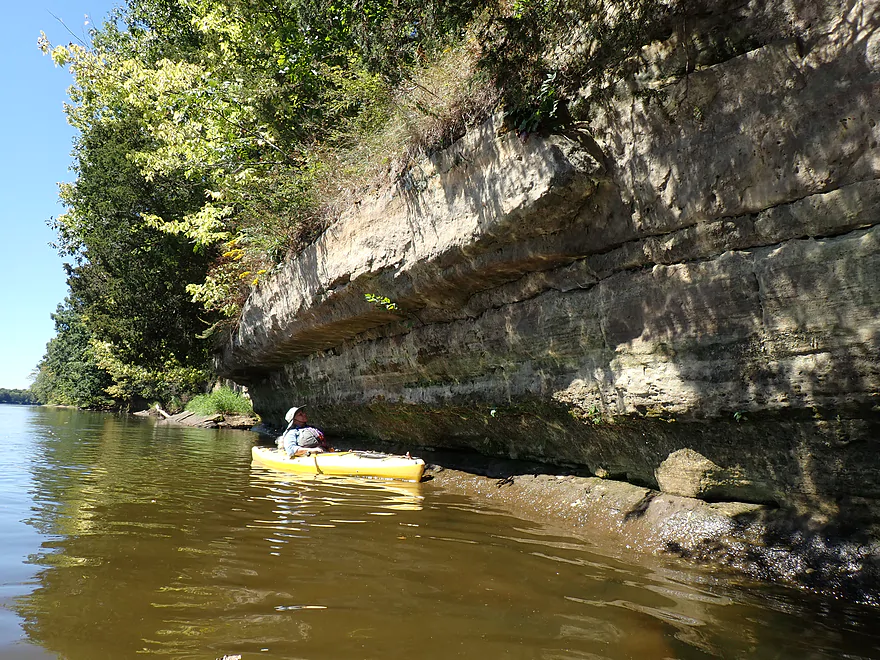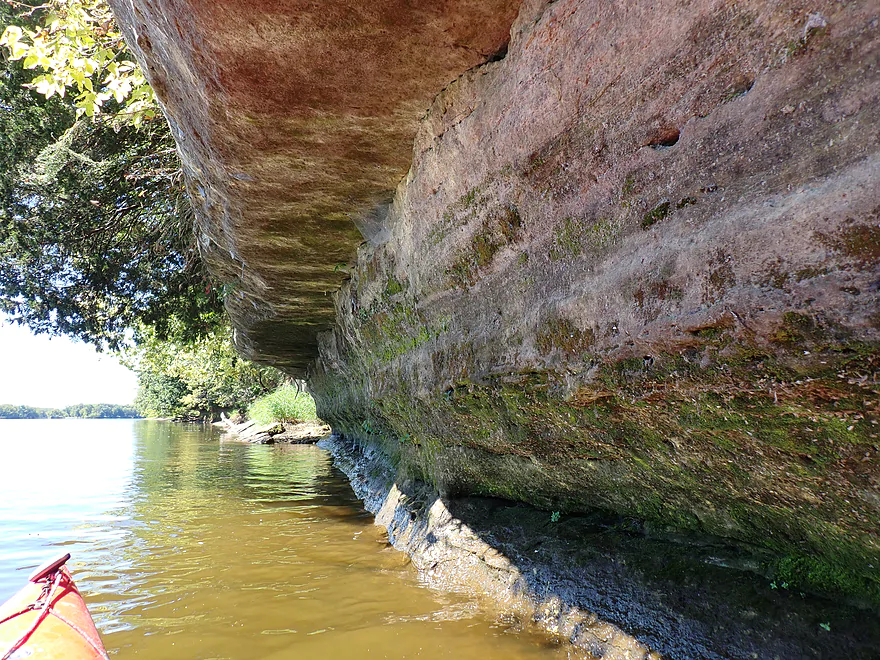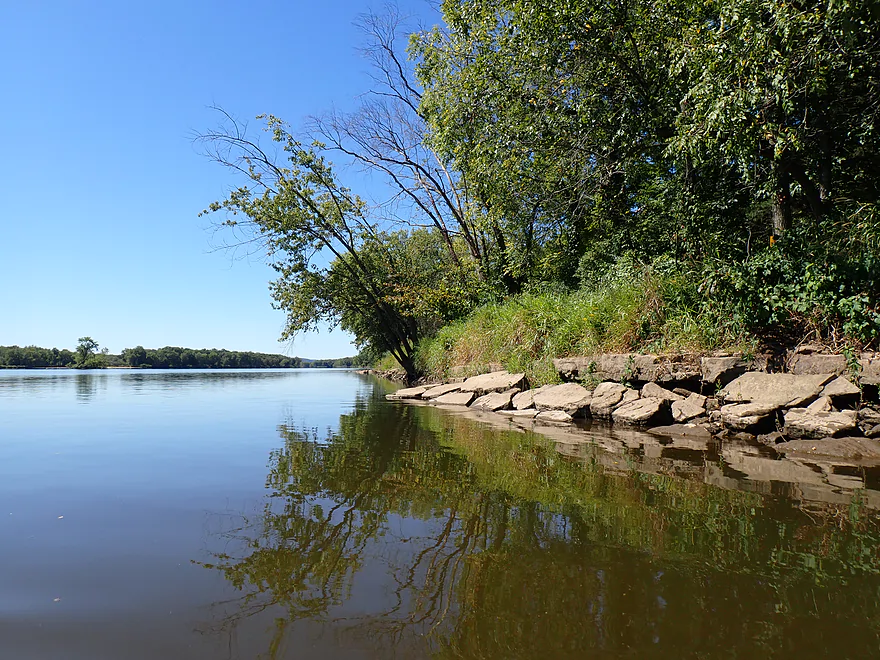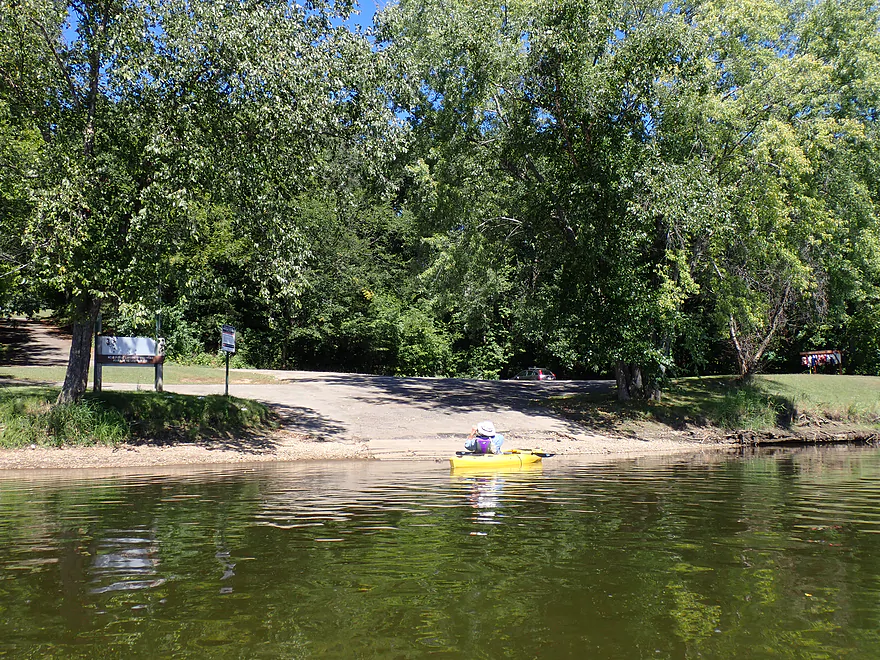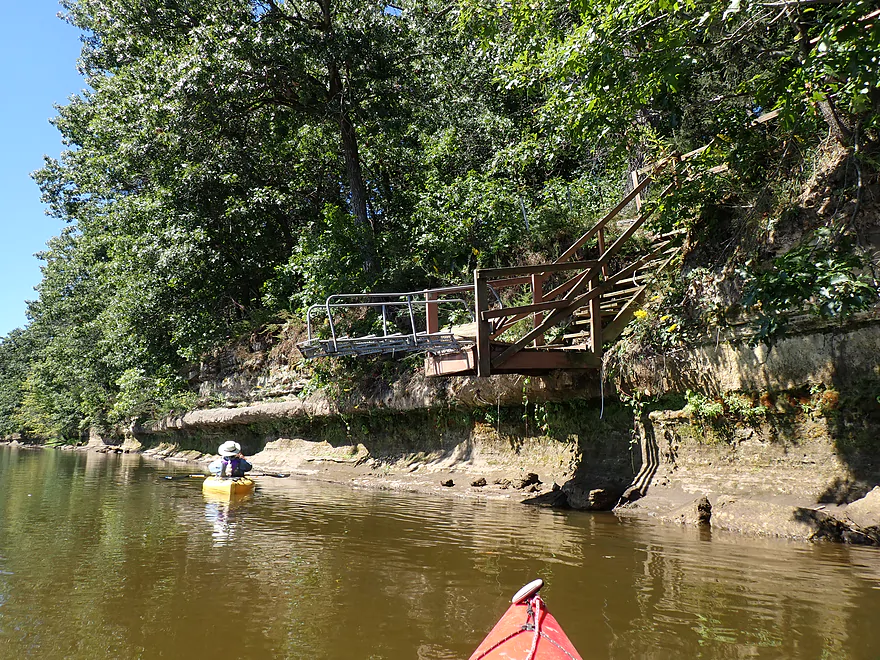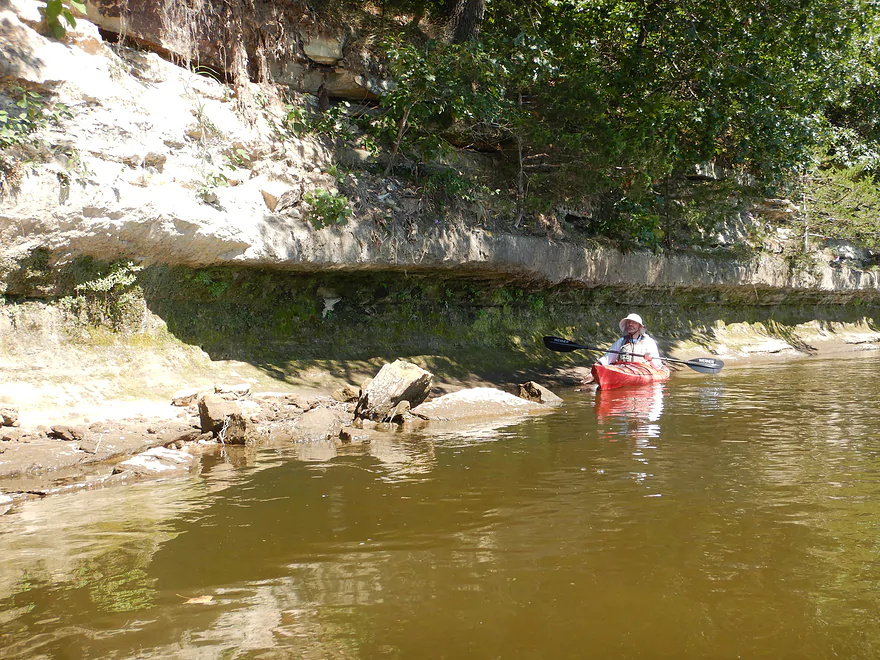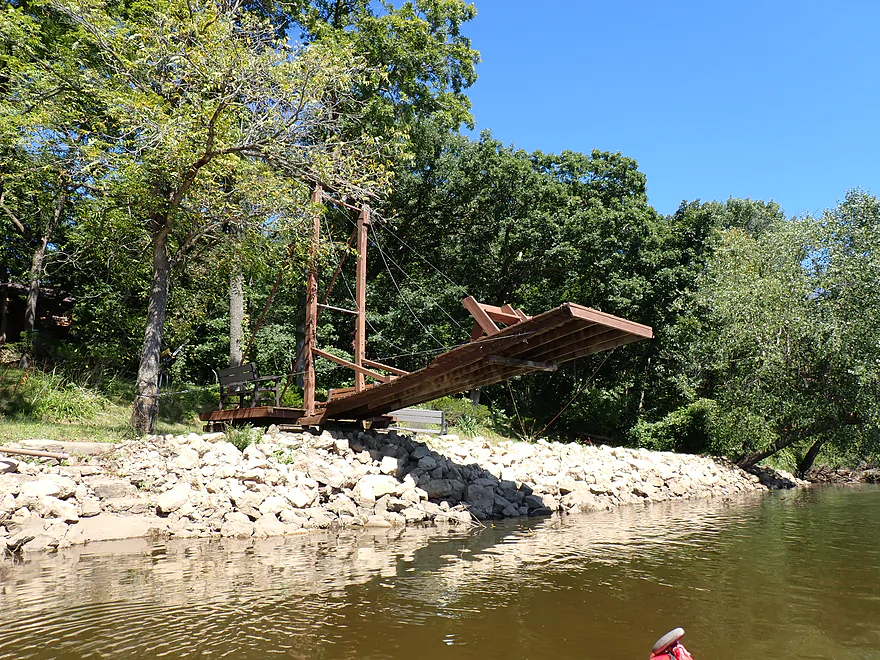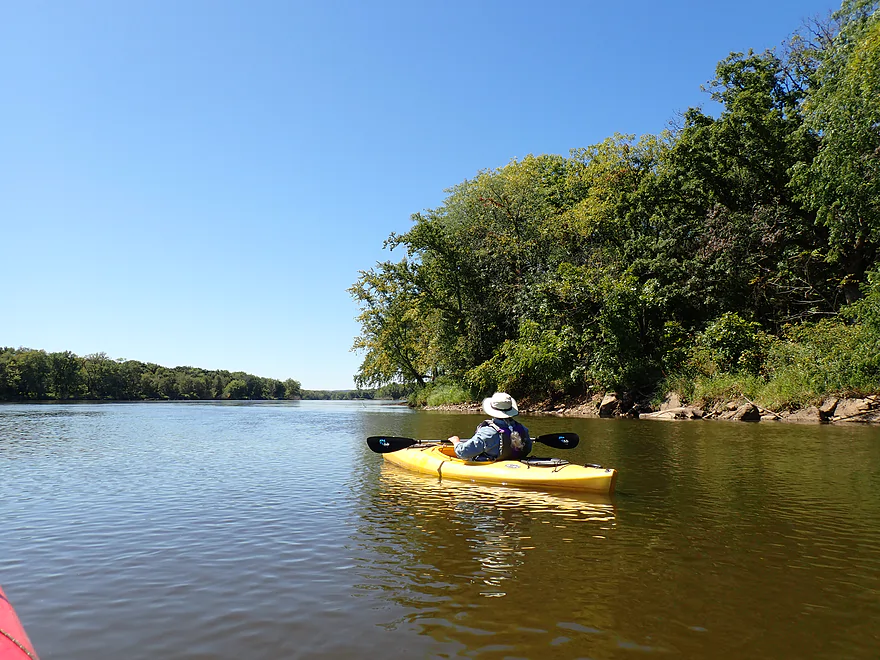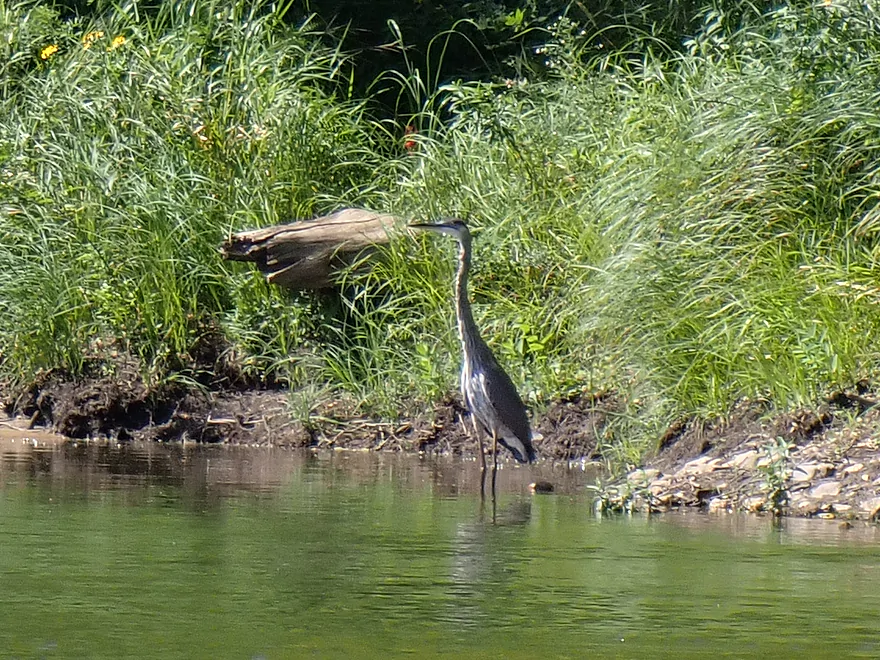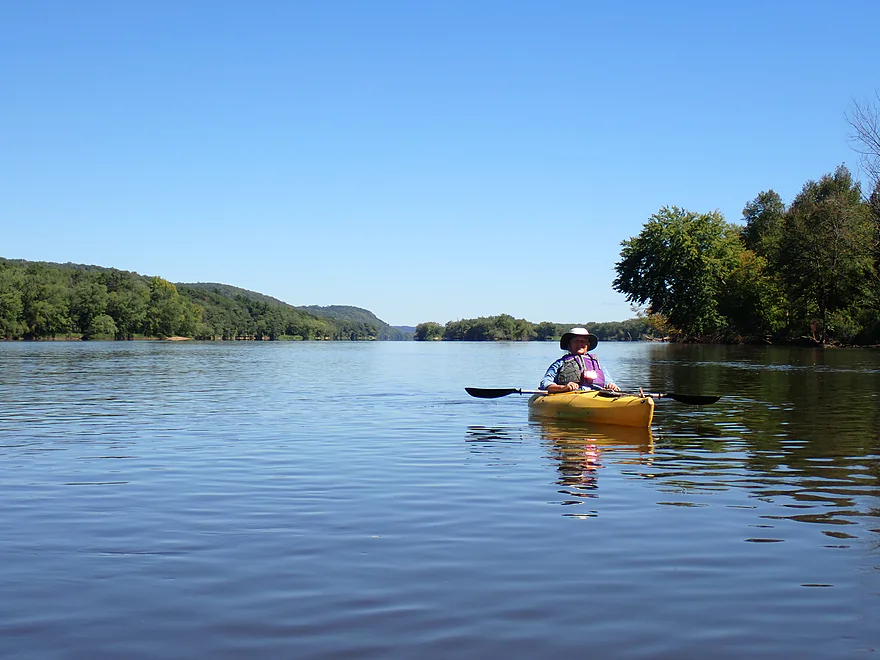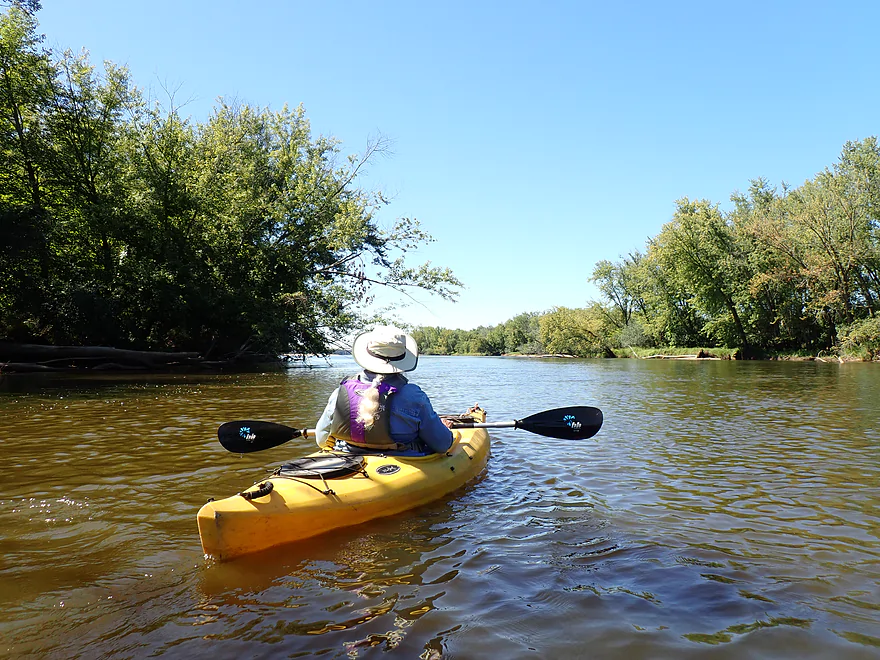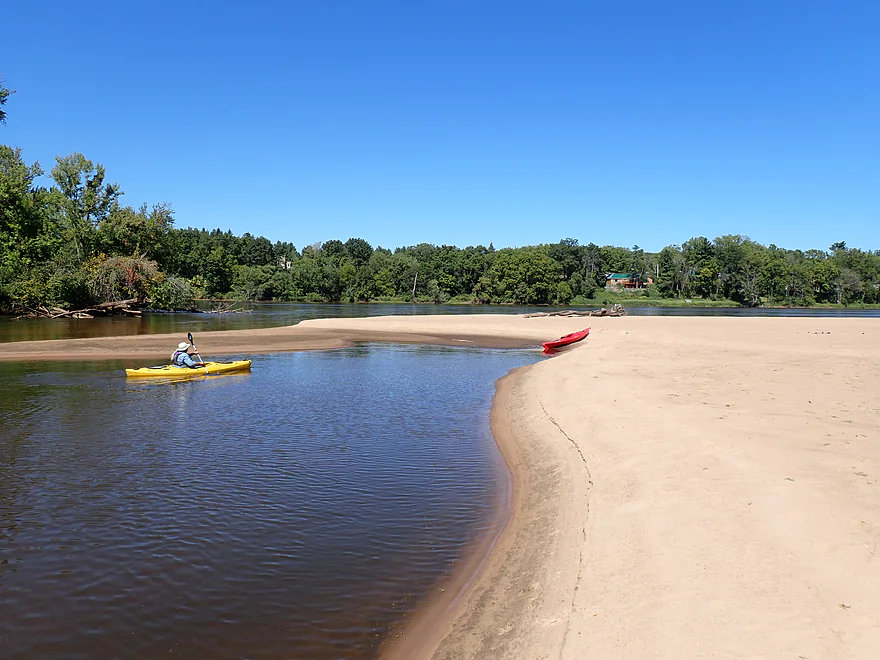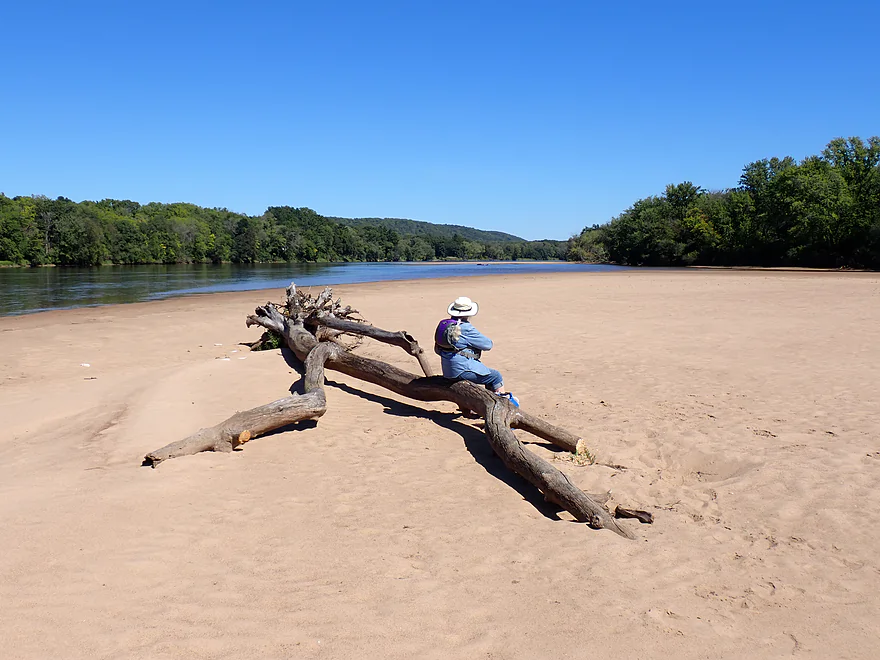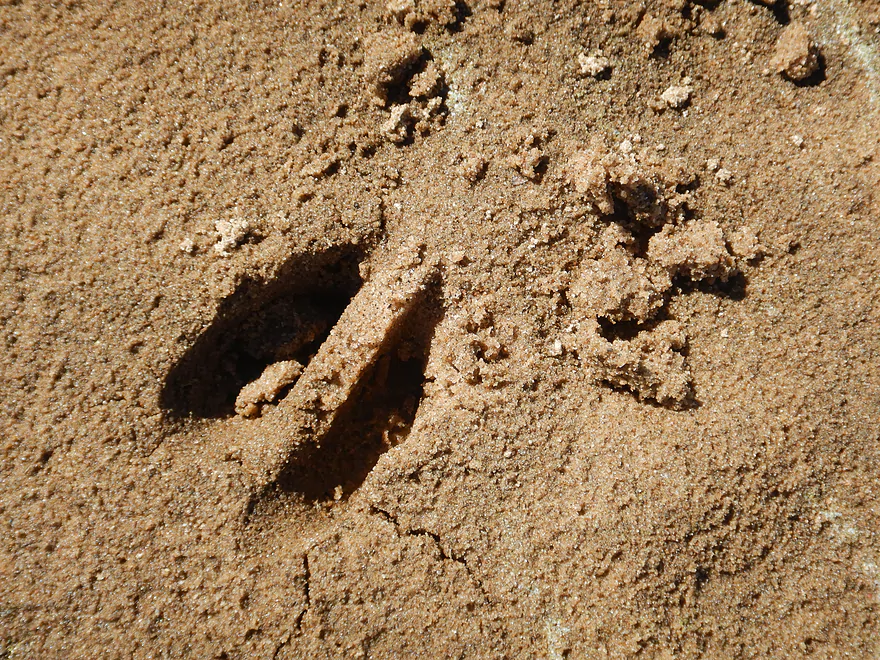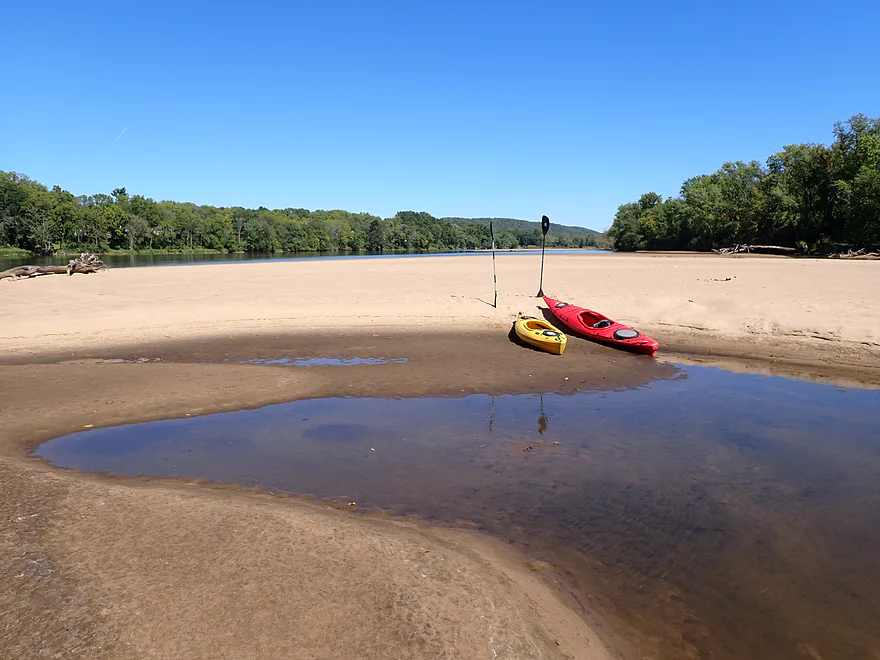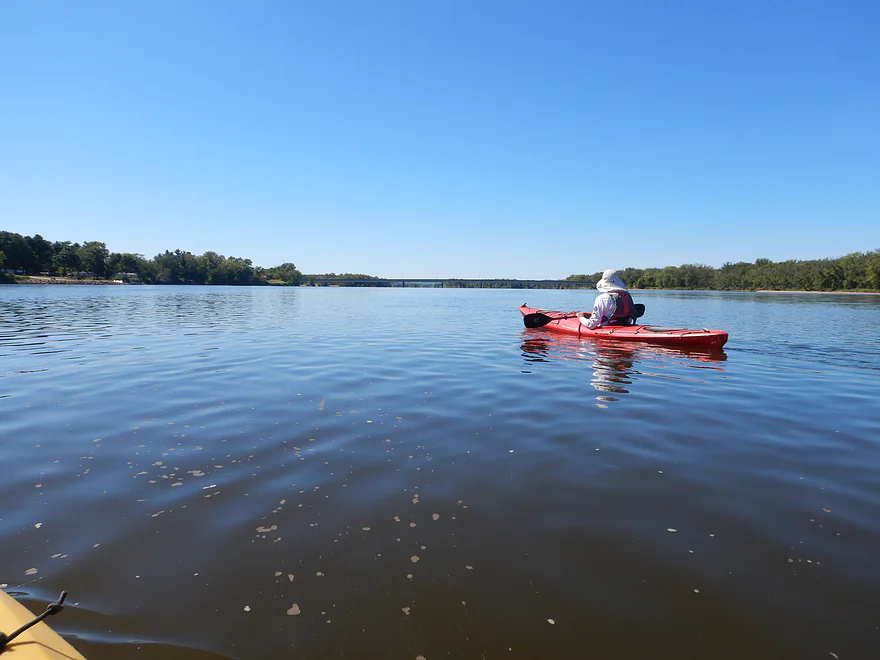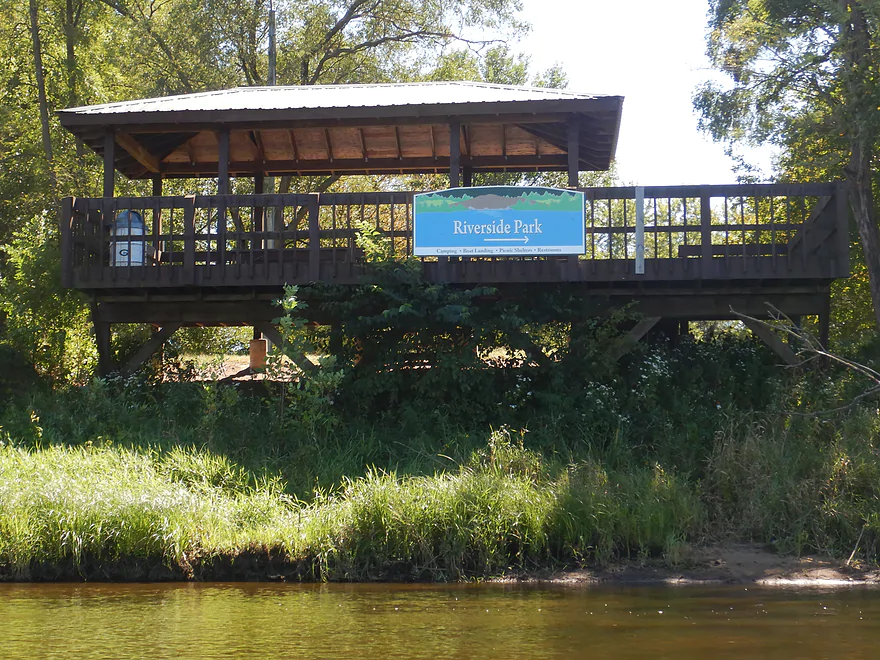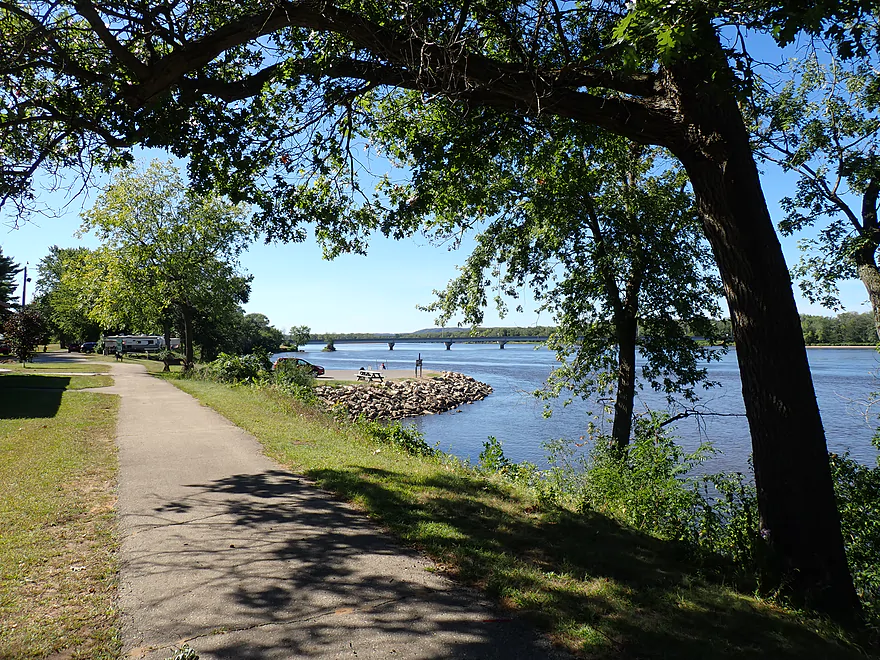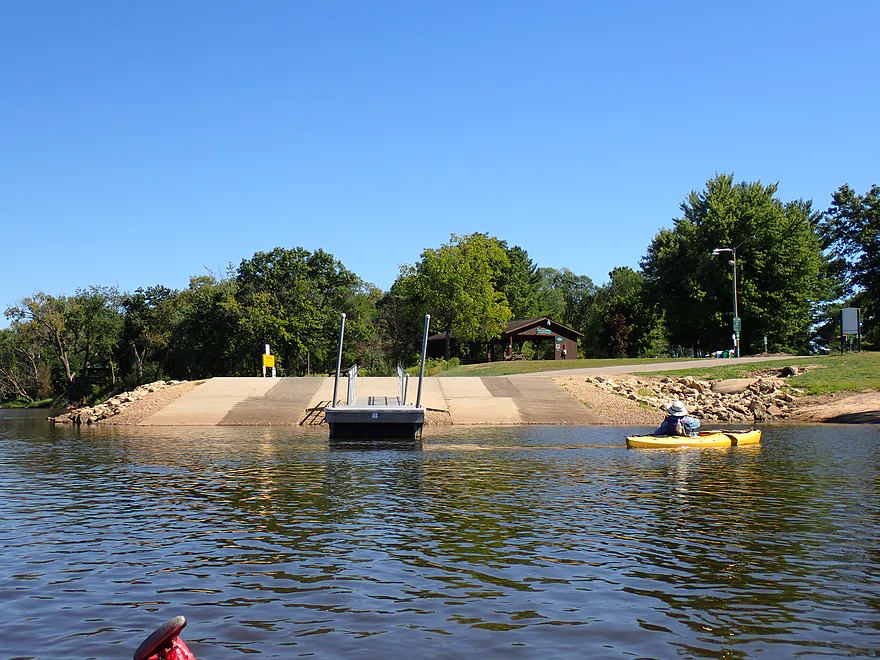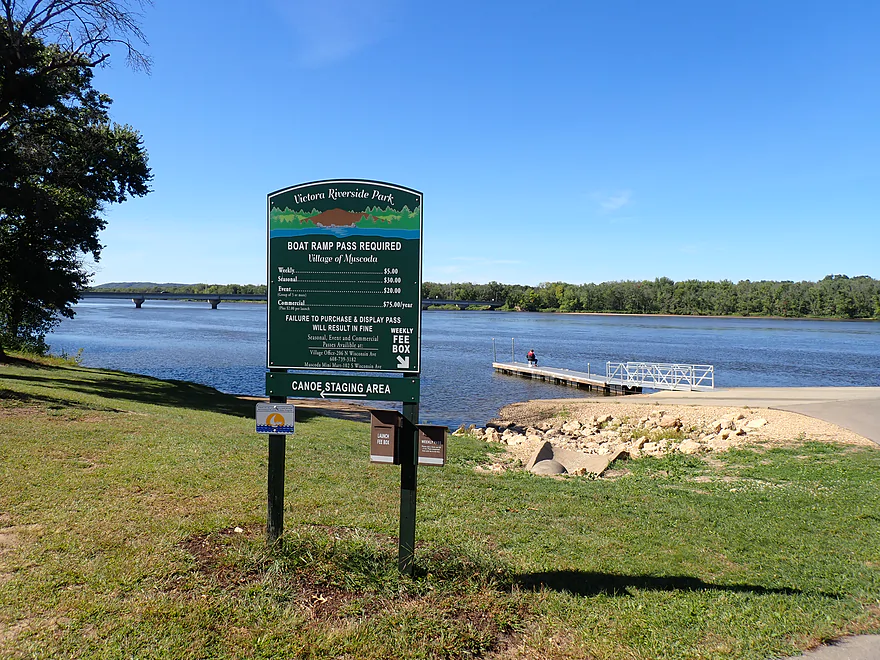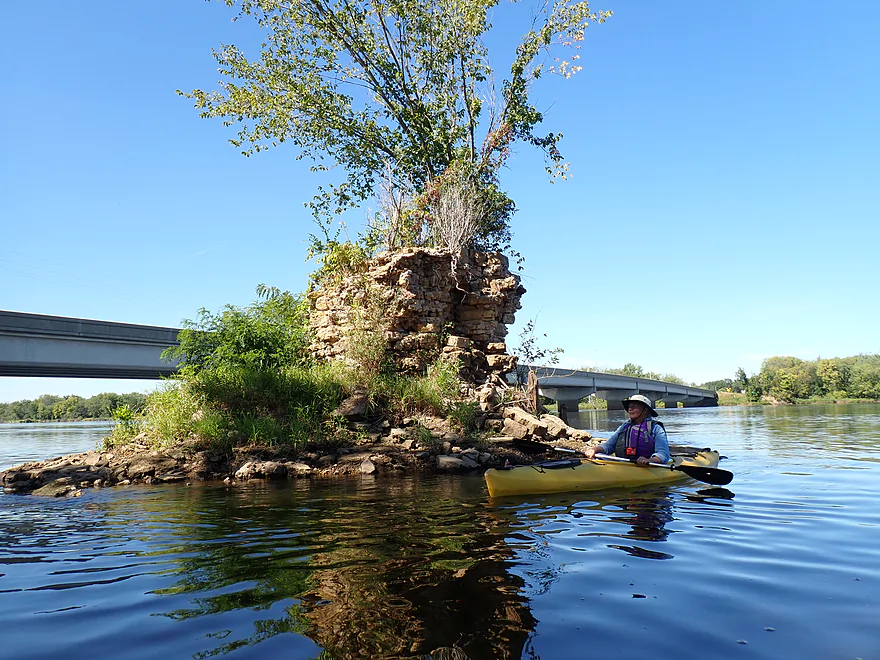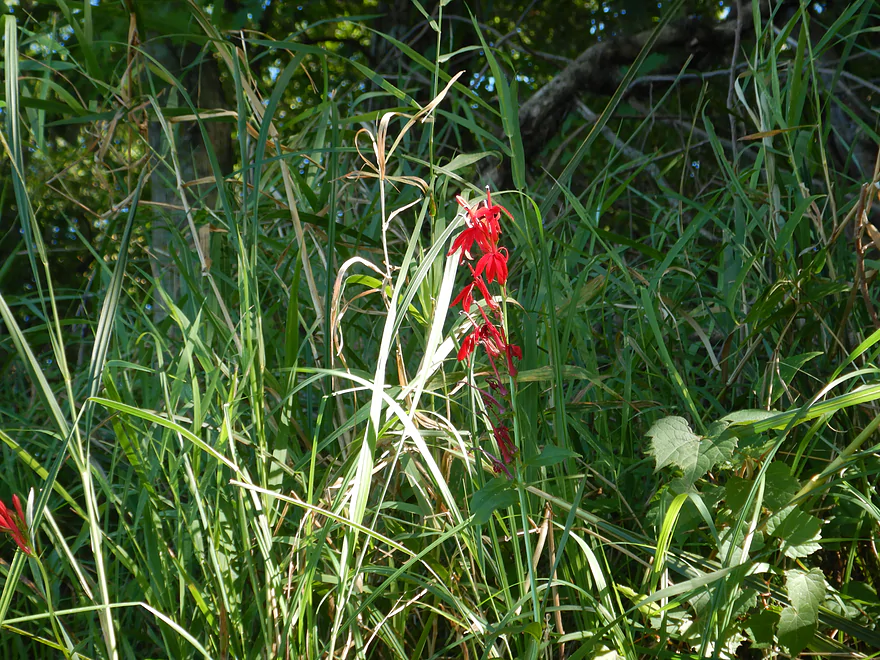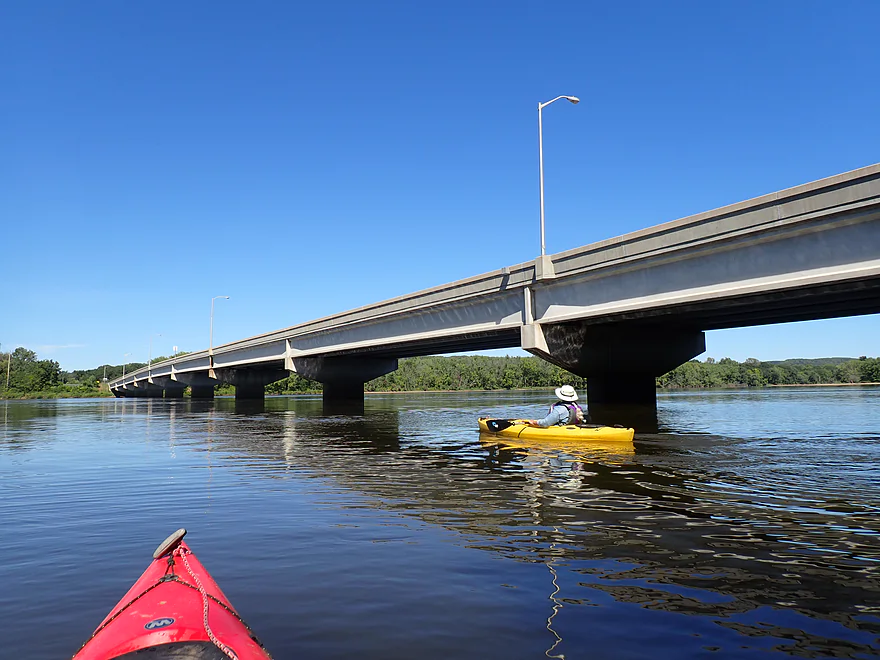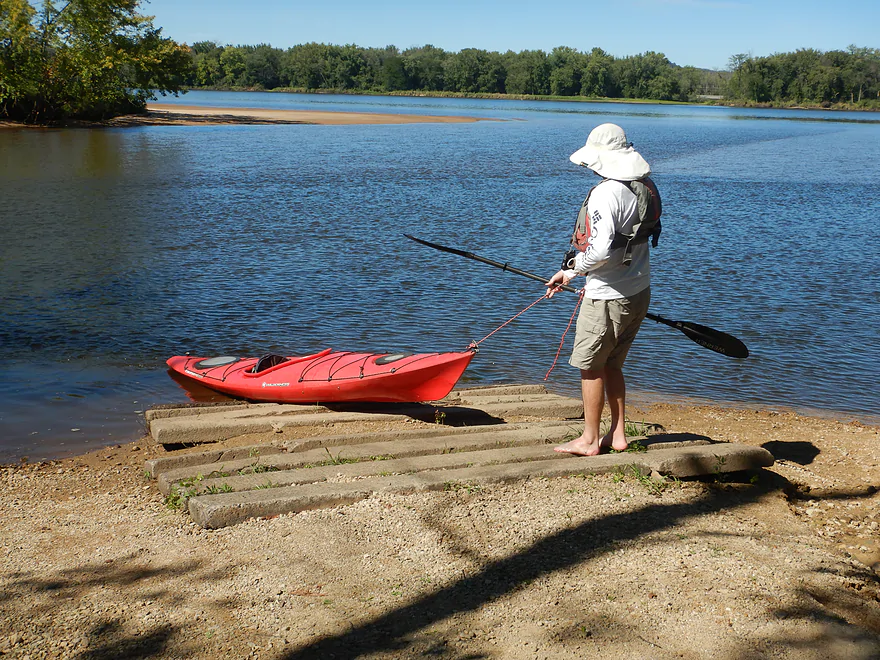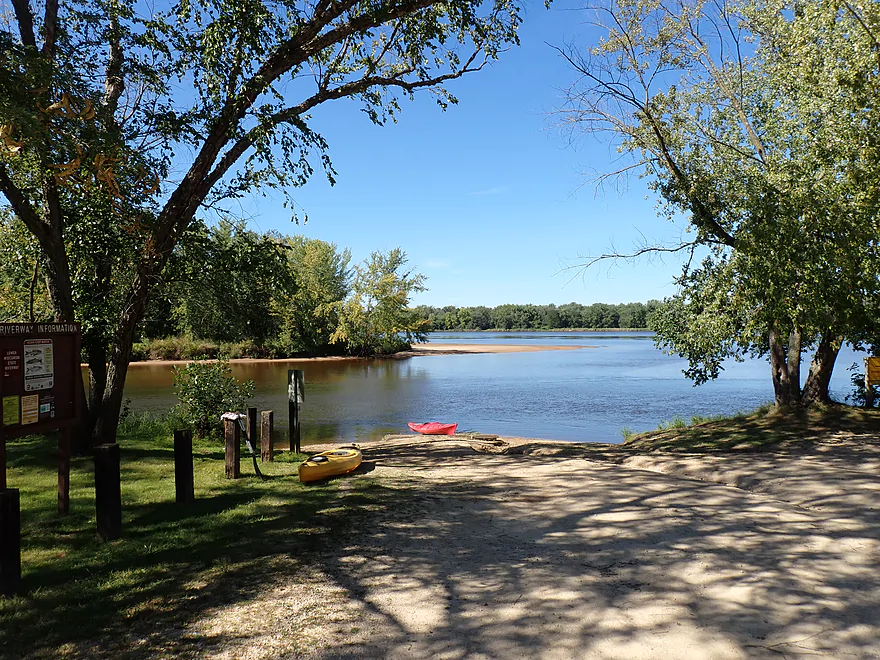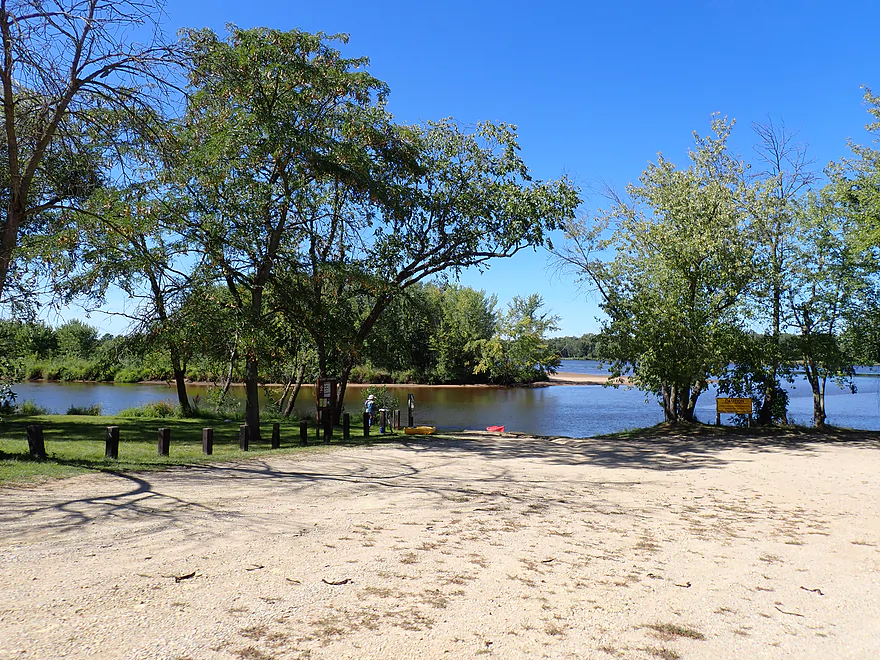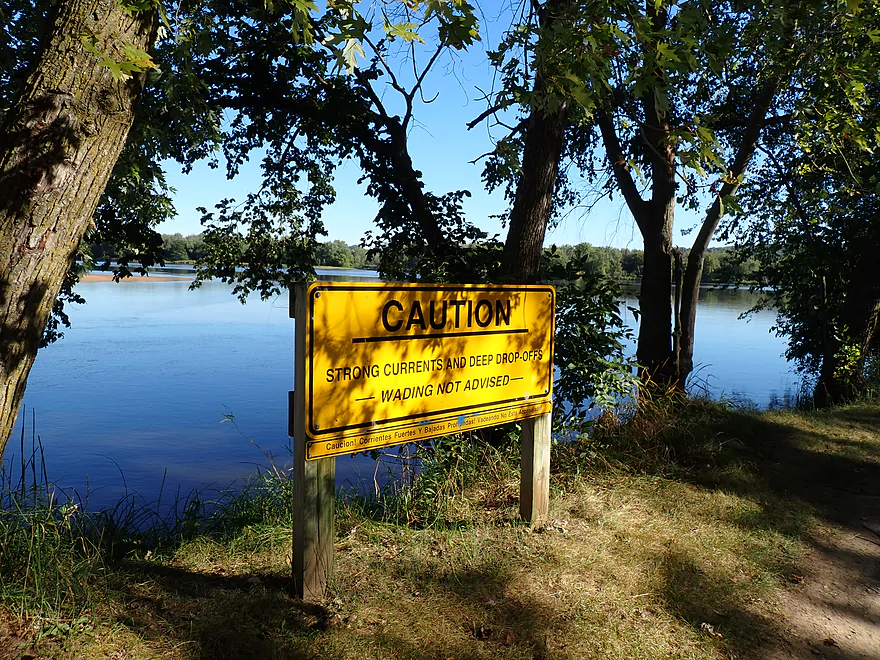Wisconsin River – Gotham
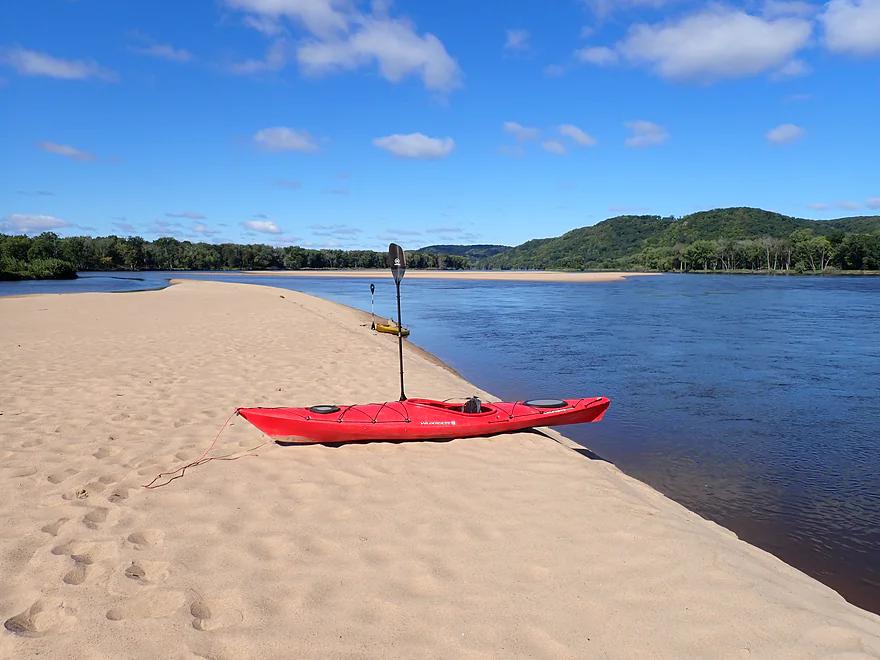





The final 92-mile stretch of the Wisconsin River from the Prairie du Sac dam to the mouth is often referred to as the “Lower Wisconsin“. It is one of the state’s best and most popular rivers for paddling, with the entire undammed distance protected as a State Riverway. Almost half of the adjacent land (45,000 out of 95,000 acres) is owned by the WI DNR. This week, I’ll review the leg between Gotham and Muscoda which is one of my favorites.
The trip started at “Buena Vista Landing” (aka Gotham Landing) located at the mouth of the Pine River, which was a good public access.
The highlight of almost any Lower Wisconsin trip are its sandbars and really, this entire stretch of river could be considered the sandbar capital of the Midwest. There are many, they are huge, and typically the sand is very clean. They are great fun to camp or picnic on. In fact, right after putting in we found an impressive 2800′-long monster where we took a scenic break.
The key to enjoying sandbars is the lack of competition. It was a warm and clear September day and yet we hardly saw anybody else on the river. As a general rule, the further west/downriver you get from Prairie du Sac (and ultimately Madison/Milwaukee/Chicago), the fewer people you’ll see. This was such a contrast to the previous week when we had to share a sandbar with about 15 other boaters during a Labor Day picnic.
After being passed by a “Huck Finn-style” raft powered by solar panels, we encountered the first of many large islands that split the river. Generally speaking you want to stay right (north). The main reason is to see the cliffs which only appear on the north bank and were another trip highlight. These were more numerous and longer than expected…very nice. Often the cliffs were topped with attractive trees like oaks and pines.
Along the north shore were a series of small homes, which was a bit surprising. Generally speaking real estate development on the Lower Wisconsin isn’t allowed, so they must have been older homes that were grandfathered in. Many of the shoreline homes were small and unobtrusive cabins located on small lots and somewhat hidden by trees. Had these been built in 2024, I’m sure they would have been huge, gaudy McMansions with ugly bright siding, clearcut eco-desert lawns, and large rip-rapped banks.
Following Bogus Valley Lane we experienced a bit of a sandbar drought, but the river remained scenic. Hwy 60 closely parallels the river and was often situated atop attractive outcrops, which I’m sure most drivers don’t realize.
After the Orion Boat Landing, the cliffs petered out, but we started to see large sandbars again. Large islands once again divided up the channel and this time we headed south to check out what Google referred to as “High Bank Island”. But instead of seeing high sand banks, we just saw generic floodbottom forests and unsightly silver maple. The south shore is lower than the north shore so bears the brunt of flooding. This is why the north shore is tidier and more attractive.
At the next slough “off ramp” we turned off and resumed paddling on the main channel and around what was probably Muscoda Island. On the west end of the island was another huge sandbar. We pulled up here to take another photo break. The sandbar was a monster…and not a person in sight. There were a few animal and bird tracks on the sandbar, but it was mostly endless pristine sand.
At this point Muscoda and the Hwy 80 bridge were in sight. We could see Muscoda’s new Victoria Riverside Park Landing, which was surprisingly large and, honestly, a bit unsightly. We passed under the bridge and past the remnants of an old bridge support. We then took out at Muscoda’s old landing off of West River Road. This landing is extremely scenic with an island and a large sandbar just across the channel.
If you count the Orion and Mil Creek landings on the north shore, Muscoda actually has 4 landings. This may seem excessive, but they all have their purpose. The new landing southeast of the bridge is really designed for motorboats, not paddlers. It also costs money and I suspect they discourage overnight parking (an issue for campers). The old Muscoda landing southwest of the bridge, in contrast, had nobody else using it (granted a Badger game may have been a factor). Regardless, the old landing is a great and scenic take-out.
In summary this was a terrific trip. The Lower Wisconsin is famous for its sandbars, bluffs, and cliffs…and this leg has all three. It’s also located far enough downstream from Prairie du Sac and Spring Green (and larger population centers), that you will see fewer people and have much less competition for the sandbars. I highly recommend this leg, especially if conditions permit (no headwind, low water for sandbars, and sunny). The current on this leg is incredibly fast (wear your life jacket), so we made great time and it would have been easy to extend the trip (such as to Port Andrew).
Sights included 2-3 bald eagles, a kingfisher, 7-8 blue herons, one water snake (frantically swimming away from my kayak), and about a dozen turtles (some painted, some map). What was remarkable were the lack of clams…three decades ago this area was a hot spot for clams and Google maps even marks part of the river as the “Orion Mussel Bed State Natural Area”. Today you’ll be lucky to see a few dead clam shells on this leg.
The Lower Wisconsin State Riverway was created in 1989 to protect the Lower Wisconsin from development. The project was massive–and probably couldn’t have happened in current times. Many meetings were held with landowners to get input and share plans. It is a tribute to all the people who worked so hard to make this project come to fruition.
Gotham Landing (aka Buena Vista Landing): This is a great public boat landing. I didn’t see any signs for fees, so I assume it is free. But signs do prohibit overnight parking (which is a bummer for canoe campers). There are no outhouses and poison ivy is everywhere, so be careful.
Alternate Put-ins:
- Lone Rock/Otter Creek Landing (7.3 miles upstream from Gotham): For those wanting a longer trip this would be a great add-on leg with more nice sandbars and scenic cliffs.
The Old Muscoda Landing: Muscoda has three landings (four if you count Orion) but this is the best for paddlers. It’s secluded, scenic, and there aren’t any fees. The boat ramp is in poor shape, which is good news because it means you won’t have to compete with motorboats launching. The only downside is there aren’t any outhouses. Note: this landing is located just downstream from the Hwy 80 bridge on the south bank.
Alternate Take-outs:
- Victoria Riverside Park Boat Landing (2400′ miles upstream from the Old Muscoda Landing): This is a modern and busy boat ramp. It’s been recently rebuilt, but honestly, is a bit gaudy with excess riprap and almost no trees. A launch fee is required, but I’m not sure if this applies to paddlers. Paddlers are warned not to stage on the main ramp, but instead use the adjacent bank. It’s an ok access option but the Old Muscoda Landing is way better for paddlers. Only take out here, if you want access to a proper restroom.
- Hwy 60/Mill Creek Landing (2000′ north of the Old Muscoda Landing): This is an obscure access option, but really, the old Muscoda Landing is better. Maybe only take out here if you’re bike shuttling and want a shorter shuttle.
- Orion Boat Landing (2.2 miles upstream from the old Muscoda Landing on the north side of the river): You could certainly get out here. It’s a nice public landing and not that many people use it. But ending a trip here might be a mistake, because just downstream there are some nice cliffs, islands and sandbars. Most paddlers will want to continue on to Muscoda.
- Port Andrew Landing (6.5 miles downstream from Muscoda): There are several landings to choose from in Port Andrew. This bonus leg would be a good option for those wanting a longer trip. This stretch would contain more nice sandbars and cliffs.
Bike Shuttle – Muscoda to Gotham: 9.8 miles with 36′ of ascent. This would be a long bike shuttle on busy Hwy 60 which has small shoulders. I advise solo paddlers to simply pay for a shuttle instead. But if you do bike shuttle, it will be scenic and there won’t be many hills to worry about.
Rentals/Shuttles: There are a number of livery and rental services for the Lower Wisconsin, and I highly recommend using my livery map to see all your options. Here are the closest services:
- River View Hills Canoe Rental: (608) 739-3472 – 24678 State Road 60, Muscoda, WI 53573
- Waz Inn: (608) 583-2086 – 234 S. Oak St., Lone Rock, WI 53556
- Wisconsin Canoe Company: (608) 432-5058 – E5016 US Hwy 14, Spring Green, WI 53588
- Wisconsin Riverside Resort: (608) 588-2826 – S13220 Shifflet Rd, Spring Green, WI 53588
- Traders Bar and Grill (aka Sandbar Canoe Rental): (608) 588-7282 – 6147 Highway 14, Arena, WI 53503
Current: This was surprisingly fast, especially close to Gotham. This definitely makes a trip more enjoyable, but it also means some downed trees along the shore are turned into dangerous strainers. You should be fine and plenty safe…just don’t paddle too close to the shoreline when there is fast current and downed trees.
Headwind: The prevailing winds blow west to east, which is a huge problem for the Lower Wisconsin. Keep an eye on the forecast and consider canceling your trip if there are 10+ mph headwinds.
Waves: While motorboats frequent the area, they aren’t super common (the shallow water and hidden sandbars make navigation precarious). Generally speaking waves shouldn’t be an issue.
Life Jackets: Some paddling trips you can get away with not wearing a life jacket, but I don’t consider the Lower Wisconsin one of them. The river is deceptively dangerous with unpredictable current, undertows, and dropoffs. Drownings are common. I highly recommend wearing a life jacket for this stretch, especially given the strong current. Many of the landings feature free loaner jackets for kids.
The key to having a great trip on the Lower Wisconsin is great timing.
- Avoid High Water: Sandbars are a highlight of any Lower Wisconsin trip…yet you won’t see them if the water is high. Also during high water the channel will be dirty and more dangerous.
- Consider a Fall Color Paddle: The lowland silver maple are weed trees with meh color…but the bluffs contain some nice oaks and sugar maple which can provide fantastic color in October.
- Avoid Spring: With exceptions…but generally speaking in the spring the water will be too cold, dirty, and high. Often the Wisconsin River doesn’t really settle down from spring floods until July.
- Avoid headwinds: These can be very challenging and common given the prevailing west-to-east wind direction.
- Consider going on a Weekday: As a general rule, the closer to Prairie du Sac you get, the more crowded the river becomes. The exceptions are weekdays where typically you’ll have the river to yourself and likely won’t have to deal with stereos, loud talking, drunk behavior, or competition for sandbars.
- Paddling Early Mornings: Paddling early means the sun will be at your back, which will translate into bluer skies and more saturated light. If you’re lucky you may even get to paddle in the fog, which can be an incredible experience.
- Paddle on Sunny Days: The scenery with the sandbars and bluffs is so much more vibrant when the sun is out.
Closest Gauge: Wisconsin River @ Muscoda
Trip Depth: 7300 CFS or 1.91′
Navigability Estimates: The following are very rough estimates. Always use your own judgement.
- 2,000-3,000 CFS: Very rarely does the river get this low. These levels would be a sandbar utopia. You might have to walk some sections but this would be easy to do in the clean sand.
- 3,001-5,000 CFS: Very ideal conditions. Great sandbars and the low levels tend to deter some motorboat traffic.
- 5,001-7,500 CFS: A common depth and ok conditions for sandbars.
- 7,501-10,000 CFS: Much smaller sandbars but still viable for camping.
- 10,001-12,500 CFS: Only the tops of the largest sandbars will be available. Likely not ideal for camping.
- 12,501-15,000 CFS: You would be lucky to see any sandbars. Water quality will likely be very murky and dirty at these levels.
- 15,001-20,000 CFS: River will be very high, pushy in spots and likely not attractive for paddling.
- 20,001+ CFS: This is too high IMO.
Quick Overview
- Upstream of Stevens Point: I don't have information yet on these stretches.
- Stevens Point to Lake Petenwell: ~42 miles. This stretch in Central Wisconsin used to have many natural rapids, but most have been buried under 8 dams, some of which are now difficult portages. Despite this there is still some good paddling to be had in this region.
- Lake Petenwell: 14.9 miles. This is a large flowage lake that is challenging for paddlers because of frequent strong winds and big waves.
- Castle Rock Lake: 14.5 miles. Another large flowage lake that is likely too big for enjoyable paddling.
- Castle Rock Lake Dam to Lemonweir River: 9.4 miles. This pre-Dells leg isn't elite, but is a pleasant stretch.
- Lemonweir River to Indian Trails Landing: 21.7 miles. This includes the famous Upper Dells and Lower Dells which feature many scenic sandstone outcrops.
- Indian Trails Landing to Portage: 16 miles. This is an overlooked section sandwiched between the Dells and Portage. While the scenery isn't top-notch, it does have many sandbars and few people, which is a nice combination.
- Portage to Lake Wisconsin: 14.3 miles. This is a neat stretch of the river with many sandbars and cliffs, but the shoreline is very developed and motorboat traffic can be heavy on weekends.
- Lake Wisconsin: 14.5 miles. This is a challenging lake for paddling because of the huge and frequent waves created by motorboats.
- Prairie du Sac Dam to Port Andrews: 57 miles. This is the first half of the famous Lower Wisconsin Riverway. This is a super popular stretch for paddlers with the highlights being large sandbars, big bluffs, occasional cliffs, and fun side sloughs to explore.
- Port Andrews to Wyalusing: 40 miles. This is the second half of the Lower Wisconsin Riverway which has far fewer paddlers and sandbars. But the bluffs and sloughs are larger and more interesting.
Detailed Overview
- Upstream of Merrill: I don't have enough information yet on these legs to comment.
- Merrill Dam to Riverside Park: 0.5 miles. Might include some light rapids below the dam.
- Riverside Park in Merrill to Wisconsin River Forest Landing: 8.6 miles. A good prospect.
- Wisconsin River Forest Landing to Brokaw Boat Landing: 5.7 miles.
- Wisconsin River Forest Landing to Jesse Park: 1.4 miles. A terrific stretch with small boulder gardens, one set of Class 1-2 rapids, gravel bars and a nice sand bank.
- Jesse Park to Brokaw Boat Landing: 4.3 miles. A good stretch with scenic wooded banks and occasional gravel bars.
- Brokaw Boat Landing to Gilbert Park: 5.1 miles. River slows down and becomes hillier. This stretch is an ok prospect and goes past the old Brokaw paper plant that has been shut down. Paddlers must navigate Class 1 rapids and a 2' drop where the old Brokaw dam used to be.
- Gilbert Park to Wausau Boat Dock: 1.5 miles. An impounded stretch through Wausau. There are numerous alternate access options to choose from.
- Wausau Boat Dock to Oak Island Boat Ramp: 1.2 miles. A nice stretch that includes Barkers Island and Isle of Ferns Park. But the Wausau dam does require a portage. This stretch parallels the famous Wausau Whitewater Park.
- Oak Island Boat Ramp to Rothschild Dam Access: 5.8 miles. Likely mostly uninteresting flowage paddling. There are many alternate access options to choose from.
- Rothschild Dam Access to Zimpro Park: 1.0 miles. This might be a nice stretch.
- Zimpro Park to River Road Boat Landing: 7.6 miles. The first half of this leg is likely nice river paddling, but the second leg is probably just an uninteresting flowage.
- Chucks Landing/Mosinee Dam to Bean's Eddy Boat Landing: 2.8 miles. Likely a nice leg. You might be able to launch by the dam where there should be some nice rapids and boulders.
- Bean's Eddy Boat Landing to Seagull Boat Landing: 5.1 miles. Mostly uninteresting flowage paddling. Although there might be some nice sand banks on the eastern shore.
- Seagull Boat Landing to Dubay Dam Access: 5.3 miles. Mostly uninteresting flowage paddling.
- Dubay Dam Access to River Road Landing: 5.5 miles. This could be a nice stretch of river.
- River Road Landing to Old US 10 Landing: 2.3 miles. Likely an ok leg.
- Old US 10 Landing to Stevens Point Dam: 5.6 miles. Probably uninteresting flowage paddling. Many alternate access options closer to Stevens Point.
- Stevens Point Dam to Blue Heron Boat Landing: 4.2 miles.
- Steven Point Dam to Whiting Dam: 2.6 miles. Starts slow and uninteresting, but the river becomes very scenic after the Hwy HH bridge. The rock formations below both dams are very striking. Many alt access points.
- Whiting Dam to Kimberly Clark Dam/Al Tech Park: 0.6 miles. Incredible scenery with exposed bedrock and boulder gardens below the Whiting Dam. Some rapids, but nothing major. The Kimberly Clark Dam is a dangerous low-head dam and should be treated carefully.
- Kimberly Clark Dam to Blue Heron Landing: 1.0 miles. Class 2 rapids below the dam, but after that the river slows dramatically and splits into many sub-channels and islands. Round trips on this leg are possible. I chose the far western channel where there were some nice rocky stretches.
- Blue Heron Landing to Mill Creek Landing: 4.1 miles. Likely a mediocre paddle with nothing special. Galecke Park is an alternate access.
- Mill Creek Landing to Biron Dam North Gate: 7.6 miles. Mostly uninteresting flowage paddling. Several alternate access options on route.
- Biron Dam North Gate to Veteran's Memorial Park: 4.5 miles.
- Biron Dam North Gate to Biron Landing: 1.0 miles. Super scenic stretch by two islands with many granite boulders.
- Biron Landing to Legion Park: 3.0 miles. A nice stretch by Big Island. The west channel is more undeveloped...but the east channel has several scenic granite islands.
- Portage through Legion Park: 680'. A steep wall separates the park from the river but in two locations the wall is short enough to get over (see map). Paddlers may want to consider a longer portage to bypass some of the shallow rocky stretches by Legion Park.
- Legion Park to Veteran's Memorial Park: 0.4 miles. A scenic stretch that features a large boulder field and the powerhouse for a large paper mill.
- Veteran's Memorial Park to Port Edwards Landing: 3.8 miles
- Veteran's Memorial Park to Demitz Park: 0.8 miles. A pleasant stretch that includes Belle Island.
- Demitz Park to Ben Hansen Park: 1.2 miles. This leg goes by Garrison Island and Edwards Island. Lyon Park is located across the river from Demitz Park and is another access option.
- Ben Hansen Park to Port Edwards Landing: 1.8 miles. Above the Centralia dam there are several small but nice islands. Portage the dam on the left bank (follow the 1000' trail through the golf course). Below the dam there are scenic rock formations. Close to the Port Edwards dam are a few more scenic islands you can explore.
- Port Edwards Landing to Nekoosa/Riverside Park: 3.6 miles.
- Port Edwards Landing to Port Edwards Powerhouse: 1.3 miles. A half-mile portage is required (east bank). A very scenic boulder field is located below the dam. At high levels, the rocks are submerged and produce a half-mile stretch of rapids (some strong).
- Powerhouse to Moccasin Creek Landing: 1.8 miles. A generic wooded stretch that isn't super interesting.
- Moccasin Creek Landing to Riverside Park: 0.5 miles. During the Nekoosa dam drawdown, this stretch had nice boulder fields and rapids.
- Riverside Park to Hwy 73: 0.8 miles. An ok stretch of the river. There are scenic cliffs south of Hwy 73, but these are past the dam warning line. Hwy 73 is not a good access option.
- Hwy 73 to Point Basse Ave (Portage of the Nekoosa Dam): 1.5 miles. A difficult 1.5 mile portage through downtown Nekoosa. Don't try to portage the south bank. There is a steep hill, cliffs, and large Domtar paper mill fences to deal with.
- Point Basse Ave to Jim Freeman Memorial Boat Landing: 0.8 miles. A generic stretch going by historic Point Basse. If you're willing to backtrack to the dam, you can see scenic boulder fields (during low flows) and a few cliffs. Point Basse Ave is a somewhat speculative access, but it seems public and doable for launching.
- Jim Freeman Memorial Boat Landing to Plank Hill Small Boat Access: 2.0 miles. A generic stretch.
- Plank Hill Small Boat Access to 19th Drive Landing: 5.3 miles. Features two epic sand banks. The main channel has some minor sandbars. Several of the side sloughs can provide fun side adventures.
- 19th Drive to the Petenwell Dam: 14.9 miles. This is Lake Petenwell which is a large and challenging lake for paddling. Waves and strong winds are frequently an issue. But when calm there are nice sandbanks on the northwest shore, hidden sloughs, and large islands to explore. See the overview map for more info.
- Petenwell Dam to Ganter Lane Landing: 3.8 miles. This stretch isn't too impacted by dams and may have nice sandbars at low levels.
- Ganter Lane Landing to Castle Rock Lake Dam: 10.7 miles. Castle Rock Lake is likely too big (wind/waves) for enjoyable paddling. There are many alternate launch options along the shore.
- Castle Rock Lake to the Lemonweir River: 10 miles. An ok section.
- Lemonweir River Mouth to River Bay Landing: 7 miles. The first half of the classic Upper Dells.
- River Bay Landing to Blackhawk Island: 6.5 miles. Second half of the classic Upper Dells, known for its fantastic outcrops. Note, the Blackhawk Island landing is no longer accessible without special permission from the Upham Woods Outdoor Learning Center.
- Black Hawk Island to Wisconsin Dells Dam: 2.0 miles. More nice sandstone outcrops. You can take out at a public ramp off Indiana Ave or portage the dam and take out SW of the dam by a launch off Wisconsin Dells Pkwy/Hwy 12.
- Dells Dam to Indian Trails Landing: 6.2 miles.
- Dells Dam to Newport Park: 2.2 miles. This is the heart of the famous Lower Dells with many scenic outcrops. Unfortunately jet boats are a serious plague on this stretch.
- Newport Park to Indian Trails Landing: 4.0 miles. Features the famous "Sugar Bowl" formation and four super cool caves. The outcrops soon disappear and this stretch is mostly uneventful (but peaceful) big river paddling.
- Indian Trails Landing to Pine Island Boat Ramp: 9.8 miles. Few paddle this stretch as it isn't as interesting. But...it does have a good concentration of sandbars and few competing paddlers for them.
- Pine Island Boat Ramp to Portage/Hwy 33 Access: 6.0 miles. Not an elite section that is lacking in cliffs and bluffs. It does have good sandbars though.
- Portage to Dekorra Park: 7.7 miles
- Portage to Baraboo River/Thunderbird Road: 5.2 miles. A good section with great sandbars. Close to Portage there are few motorboats.
- Baraboo River to Dekorra Park: 2.5 miles. River splits around massive Lib Cross Island. West channel has nice sandbars. St Lawrence Bluff has scenic sandstone outcrops and includes a cave you can paddle into.
- Dekorra Park to James Whalen Memorial Park: 6.6 miles.
- Dekorra Park to Camp Rest Park: 5.1 miles. A terrific section with rock outcrops, large island deltas, hidden sloughs, and nice sandbars. Unfortunately this part of the river is popular with motorboats and jet skis which can be a plague. Multiple alternate access options.
- Camp Rest Park to James Whalen Memorial Park: 1.5 miles. Not a great section because of the open water paddling, powerboats and big waves. The west shore though does have nice outcrops.
- James Whalen Memorial Park to Merrimac Memorial Park: 4.4 miles. River turns into "Lake Wisconsin". Generally speaking this isn't ideal for kayaking as motorboat traffic can be heavy and waves can be surprisingly big. The most direct route is the north shore which has a few bluffs, but generally speaking isn't that interesting.
- Merrimac Memorial Park to Veterans Memorial Park/Prairie du Sac: 9.6 miles.
- Merrimac Memorial Park to Moon Valley Landing: 3.3 miles. Includes a lot of developed shoreline. The ferry, railroad bridge, and Moon Bay are highlights.
- Moon Valley Landing to Veterans Memorial Park/Prairie du Sac: 6.3 miles. Other than Moon Bay and the dam, this is a boring stretch. There are numerous alt access options on this route.
- Prairie du Sac to Mazomanie: 8 miles. An ok section of the Wisconsin but lacking in sandbars.
- Mazomanie to Arena: 9.7 miles. A great section with nice sandbars and scenic bluffs.
- Arena to Hwy 14: 8.0 miles. Good section with a high concentration of sandbars. One of the more popular legs on the Lower Wisconsin.
- Hwy 14 to Hwy 23/Spring Green: 2.2 miles. Neat mini-section with sandstone outcrops. Very popular in the summer.
- Spring Green to Lone Rock: 7.4 miles. Another fine sandbar/bluff section with some nice rock outcrops too.
- Lone Rock to Gotham: 8 miles. This stretch has super impressive rock outcrops and sand banks.
- Gotham to Muscoda: 7.6 miles. This leg includes more large sandbars and great outcrops. Bonus highlights include fast current and not seeing as many people.
- Muscoda to Port Andrew: 7 miles. A good stretch with many islands and sandbars.
- Port Andrew to Boscobel: 9 miles. Wooded islands start to get massive.
- Boscobel to Woodman/Big Green River: 9 miles and start of the less paddled stretch of the Lower Wisconsin. Far fewer sandbars from here to the mouth, but good bluffs and side sloughs to explore.
- Woodman to Millville: 7.7 miles. A good stretch with large bluffs and sandbars.
- Millville to Bridgeport: 5.3 miles. Huge islands, bluffs and sandbars are the highlight on this second-to-last leg on the Wisconsin River.
Bridgeport to Wyalusing (the mouth): 9 miles.

